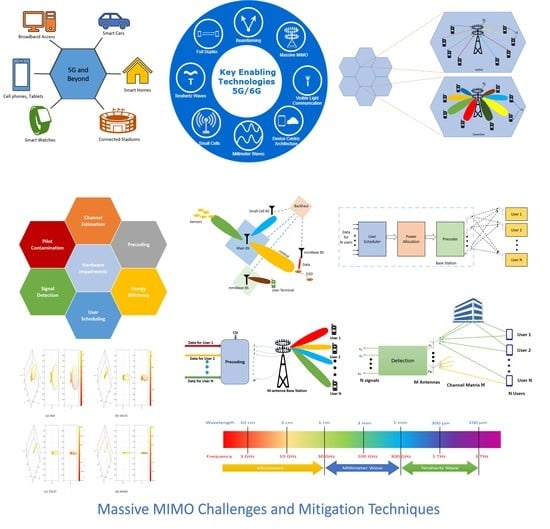Massive MIMO Systems for 5G and beyond Networks—Overview, Recent Trends, Challenges, and Future Research Direction
Abstract
1. Introduction
2. Evolution of Cellular Networks
2.1. 1G
2.2. 2G
2.3. 2.5G and 2.75G
2.4. 3G
2.5. 3.5G
2.6. 4G
2.7. 5G
- Data rate: 5G network would provide data rate up to 10 Gbps, which is almost a hundred times better than 4G networks.
- Latency: 5G network provides latency as low as 1 ms compared to 10 ms latency provided by 4G networks.
- Efficient signaling: 5G networks provide efficient signaling for IoT connectivity and M2M communication.
- User experience: 5G enhances augmented reality, virtual reality, and artificial intelligence.
- Spectral efficiency: 5G would provide ten times more spectral and network efficiency compared to 4G networks.
- Energy efficiency: 5G networks provide 90 % more efficient network energy usage compared to 4G networks.
- Ubiquitous Connection: 5G provides huge broadcasting data, which can support more than 65,000 connections, which is a hundred times more than 4G networks.
- Battery life: 5G provides almost ten years of battery life for low powered IoT devices.
- Frequency bands: Frequency bands up to 300 GHz have been considered for 5G networks. These high-frequency bands are costly, and wireless carriers will have to pay millions to get this high-frequency spectrum.
- Coverage: The high-frequency wave has a shorter wavelength; thus, it cannot travel to a longer distance. Due to this issue, there should be more base stations in a smaller area to give each user a reliable connection. The additional base station increases the cost and complexity of the overall network.
- Cost: Since 5G is not just about adding an extra layer to the 4G network, the cost to build the system from the base level is prohibitive.
- Device Support: Since the phones available in the current market does not support 5G infrastructure, and it would be a challenge for device manufacturers to develop cheaper phone which can support 5G.
- Security and Privacy: Although 5G uses the authentication and Key Agreement (AKA) system, it is still venerable from attacks such as middle man attack, location tracking, and eavesdropping.
- Availability: With the introduction of M2M and IoT, network overload and congestion would be a major problem in the future. These radio access network challenges will make it difficult to make the network available to everyone.
- Cybercrime: With high speed, data Cybercrime would increase drastically. Thus, strict Cyberlaws would be necessary to prevent these attacks.
2.8. 6G
- Data rate: 6G network is expected to provide data rate up to 10 Tbps, which is almost a hundred times better than 5G networks.
- Latency: 6G network would provide latency as low as 0.1 ms compared to 1 ms latency provided by 5G networks.
- Efficient signaling: 6G networks provide efficient signaling for massive IoT connectivity and M2M communication.
- User experience: 6G enhances extended reality, augmented reality, virtual reality, and artificial intelligence.
- Spectral efficiency: 6G would provide ten times more spectral and network efficiency compared to 5G networks.
- Energy efficiency: 6G networks provide 100 times more efficient network energy usage compared to 5G networks.
- Ubiquitous Connection: 6G will provide huge broadcasting data, which can support more than 1 million connections, which is almost a hundred times more than 5G networks.
3. Key Enabling Technologies for 5G and Beyond Networks
3.1. Millimeter Waves
3.2. Sub-Millimeter or Terahertz Band
3.3. Small Cells or Heterogeneous Networks
3.4. Beamforming
3.5. Device Centric Architecture
3.6. Full Duplex Technology
3.7. Visible Light Communication
3.8. Massive MIMO
3.8.1. Uplink Transmission
3.8.2. Downlink Transmission
4. Benefits of Massive MIMO for 5G Networks and Beyond
- Spectral Efficiency: Massive MIMO provides higher spectral efficiency by allowing its antenna array to focus narrow beams towards a user. Spectral efficiency more than ten times better than the current MIMO system used for 4G/LTE can be achieved.
- Energy Efficiency: As antenna array is focused in a small specific section, it requires less radiated power and reduces the energy requirement in massive MIMO systems.
- High Data Rate: The array gain and spatial multiplexing provided by massive MIMO increases the data rate and capacity of wireless systems.
- User Tracking: Since massive MIMO uses narrow signal beams towards the user; user tracking becomes more reliable and accurate.
- Low Power Consumption: Massive MIMO is built with ultra lower power linear amplifiers, which eliminates the use of bulky electronic equipment in the system. This power consumption can be considerably reduced.
- Less Fading: A Large number of the antenna at the receiver makes massive MIMO resilient against fading [42].
- Low Latency: Massive MIMO reduces the latency on the air interface [43].
- Robustness: Massive MIMO systems are robust against unintended interference and internal Jamming. Also, these systems are robust to one or a few antenna failures due to large antennas [44].
- Enhanced Security: Massive MIMO provides more physical security due to the orthogonal mobile station channels and narrow beams [47].
- Low Complex Linear Processing: More number of base station antenna makes the simple signal detectors and precoders optimal for the system.
5. Why Is Massive MIMO Becoming More Important for 5G Networks and beyond?
6. Challenges in Massive MIMO and Mitigation Techniques
6.1. Pilot Contamination
6.2. Channel Estimation
6.3. Precoding
6.4. User Scheduling
6.5. Hardware Impairments
6.6. Energy Efficiency
6.7. Signal Detection
7. Can Our Current Mobile Phones Use Massive MIMO Technology?
8. Machine Learning and Deep Learning for Massive MIMO Systems
9. Active Research Topics on Massive MIMO for 5G and beyond Networks
- Massive MIMO system depends upon a large number of antennas to reduce the effect of noise, fading, and interference. A large number of antennas in massive MIMO increases the system complexity and increases the hardware cost. To deploy massive MIMO, it should be built with low cost and small components to reduce the computational complexity and hardware size. The low-cost equipment will increase the hardware imperfections such as phase noise, magnetization noise, amplifier distortion, and IQ imbalance. Although the hardware impairment cannot to completely removed, its influence can be mitigated with proper use of compensation algorithms. Design of these compensation algorithms is a good area of research in massive MIMO.
- Since there are limit number of orthogonal pilots that can be used in a particular time, the pilot contamination becomes one of the significant challenges in massive MIMO deployment. Pilot contamination increases interference and limits the achievable throughput. Several research has been conducted to mitigate the effect of pilot contamination. However, there is a need for an optimal method that mitigates its effect [58,59,60,61,62,63,64,65,66,67,68,69,70]. Thus, effective ways to mitigate the pilot contamination effect is an essential area to investigate.
- Although the precoding techniques increase throughput and reduce interference, it increases the computational complexity of the overall system by adding extra computations. This computational complexity increases with a large number of antennas. Thus, it is more practical to use low complex and efficient precoders in massive MIMO. Through investigation to find efficient precoding technique for massive MIMO is also an essential area of research.
- Since there are a limited number of antennas in the massive MIMO base station, user scheduling has to be performed if the number of the users is more than the number of antenna terminals at the base station. Massive MIMO system throughput can be increased by only scheduling the users experiencing good channel conditions. But using this scheme, the users at the edge of the cell with poor channel conditions are ignored and never scheduled. To improve overall system performance, a certain amount of fairness must be ensured among all the users. Several research has been conducted to achieve an efficient user scheduling algorithm [92,105,106,107,108,109,110,111,112,113,114,115], but optimal performance has not been achieved. Further research should be conducted to find a more efficient and fair scheduling algorithm design that can provide a higher data rate and guarantee fairness among users.
- In massive MIMO systems, due to a large number of antennas, the uplink signal detection becomes computationally complex and reduces the achievable throughput. Also, all the signals transmitted by users superimpose at the base station to create interference, which also contributes to the reduction of throughput and spectral efficiency. A recent experiment has achieved near-optimal performance, but more efficient algorithms are required to realize massive MIMO [47,74,86,122,123,124,125,126,127,128,129,130,131,132,133,134,135,136,137,138,139,140,141,142,143]. One of the crucial areas of investigation is to find more efficient and low complex uplink signal detection algorithm.
- Accurate CSI is needed in massive MIMO for beamforming data, detecting user signal, and resource allocation [168]. The user terminal has to estimate signal coming from a large number of antennas at the base station. Furthermore, the pilot overhead also increases drastically. Thus, an efficient channel estimation scheme with reasonable pilot overhead is an exciting area to investigate, particularly for FDD scheme.
- An exciting area for research in massive MIMO will be to combine it with quantum communication with a frequency higher than 300 GHz.
- Massive MIMO technology will be used for a user having a large number of antennas. Massive MIMO transceiver design, complexity, performance should be tested with users having a large number of antennas.
- Since the phones available in the current market does not support massive MIMO infrastructure; it would be a challenge for device manufacturers to develop cheaper phone which can support this technology. Design of a massive MIMO system that can integrate with the current 4G network is an excellent area to study.
- The use of machine learning and deep learning algorithms during massive MIMO channel estimation to predict statistical channel characteristics is an exciting area of research. Several experiments have been conducted recently to explore machine learning and deep learning for massive MIMO channel estimation, user scheduling, beamforming, and signal detection [90,149,150,151,152,153,154,155,156,157,158,159,160,161,162,163,164,165,166,167].
- The study on potential key enabling technologies for 6G networks such as THz communication, visible light communication, and holographic radio is also an interesting area to investigate.
- Further investigation is required to realize THz UM-MIMO for 5G and beyond networks. Some of the areas to the important area to investigate are the fabrication of plasmonic nano array antennas, optimal channel estimation methods, low complex and efficient precoding, and signal detection algorithms, accurate beamforming, and beemsteering [16,17].
10. Conclusions
Author Contributions
Funding
Acknowledgments
Conflicts of Interest
Abbreviations
| MIMO | Multiple-input multiple-output |
| IoT | Internet of things |
| M2M | Machine to machine |
| LTE | Long term evolution |
| LAN | Local area network |
| MAC | Media access control |
| FDMA | Frequency division multiple access |
| AMPS | Advanced mobile phone systems |
| TACS | Total access communication system |
| TDMA | Time division multiple access |
| CDMA | Code division multiple access |
| 3GPP | 3rd Generation Partnership Project |
| GSM | Global system for mobile communication |
| GPRS | General packet radio service |
| EDGE | Enhanced data GSM evolution |
| MMS | Multimedia message support |
| HSPA+ | High speed packet access |
| HSDPA | High speed downlink packet access |
| HSUPA | High speed uplink packet access |
| QoS | Quality of service |
| HDTV | High definition television |
| WiMAX | Worldwide interoperability for microwave access |
| QAM | Quadrature amplitude modulation |
| IMT | International mobile telecommunications |
| CSI | Channel state information |
| CS | Compressed sensing |
| FDD | Frequency division duplexing |
| TDD | Time division duplexing |
| LS | Lease square |
| MMSE | Minimum mean square error |
| DPP | Dirty paper precoding |
| TH | Tomlinson Harashima |
| VP | Vector perturbation |
| MRC | Maximal ratio combining |
| ZF | Zero-Forcing |
| R-ZF | Regularized zero-forcing |
| WF | Water filling |
| RR | Round robin |
| PF | Proportional fair |
| PLL | Phase-locked loop |
| PAPR | Peak to average power ratio |
| SD | Sphere decoder |
| SIC | Successive interference cancellation |
| NSA | Neumann series approximation |
| SOR | Successive over-relaxation |
| ADMM | Alternating direction method of multipliers |
| AMP | Approximate message passing |
| DL | Deep learning |
| CNN | Convolutional neural networks |
| RNN | Recurrent neural networks |
| DNN | Deep neural networks |
| LSTM | Long short-term memory |
| NARX | Nonlinear autoregressive network with exogenous inputs |
| ARN | Autoregressive network |
| SSL | Semi-supervised learning |
| SL | Supervised learning |
| MICED | MIMO iterative channel estimation and decoding |
| VAMP | Variational approximate message passing |
| APRGS | Accelerated and Preconditioned Refinement of Gauss-Seidel |
| UM-MIMO | Ultra massive MIMO |
| SU-MIMO | Single user MIMO |
| MU-MIMO | Multi user MIMO |
| VLC | Visible light communication |
References
- Young, G.O. Synthetic structure of industrial plastics. In Plastics, 2nd ed.; Peters, J., Ed.; McGraw-Hill: New York, NY, USA, 1964; Volume 3, pp. 15–64. [Google Scholar]
- Cisco Visual Networking Index: Forecast and Trends, 2017–2022, White Paper c11-741490-00. Available online: https://www.cisco.com/c/en/us/solutions/collateral/service-provider/visual-networking-index-vni/white-paper-c11-741490.pdf (accessed on 20 January 2020).
- Cisco Visual Networking Index: Global Mobile Data Traffic Forecast Update, 2017–2022, White Paper C11-738429-01. Available online: https://www.cisco.com/c/en/us/solutions/collateral/service-provider/visual-networking-index-vni/white-paper-c11-738429.pdf (accessed on 20 January 2020).
- A Closer Look at Massive MIMO. Available online: https://business.sprint.com/blog/massive-mimo (accessed on 20 January 2020).
- Rusek, F.; Persson, D.; Lau, B.K.; Larsson, E.G.; Marzetta, T.L.; Edfors, O.; Tufvesson, F. Scaling up MIMO: Opportunities and Challenges With Very Large Arrays. IEEE Signal Process. Mag. 2013, 30, 40–60. [Google Scholar] [CrossRef]
- Larsson, E.G.; Tufvesson, F.; Edfors, O.; Marzetta, T.L. Massive MIMO for Next Generation Wireless Systems. IEEE Commun. Mag. 2014, 52, 186–195. [Google Scholar] [CrossRef]
- Marzetta, T.L. Massive MIMO: An Introduction. Bell Labs Tech. J. 2015, 20, 11–22. [Google Scholar] [CrossRef]
- Wu, X.; Beaulieu, N.C.; Liu, D. On Favorable Propagation in Massive MIMO Systems and Different Antenna Configurations. IEEE Access 2017, 5, 5578–5593. [Google Scholar] [CrossRef]
- Lopa, V. Evolution of mobile generation technology: 1G to 5G and review of upcoming wireless technology 5G. Int. J. Mod. Trends Eng. Res. 2015, 2, 281–290. [Google Scholar]
- Rangan, S.; Rappaport, T.S.; Erkip, E. Millimeter-wave cellular wireless networks: Potentials and challenges. Proc. IEEE 2014, 102, 366–385. [Google Scholar] [CrossRef]
- Xiao, M.; Mumtaz, S.; Huang, Y.; Dai, L.; Li, Y.; Matthaiou, M.; Karagiannidis, G.K.; Björnson, E.; Yang, K.; Chih-Lin, I.; et al. Millimeter-wave communications for future mobile networks (guest editorial), part I. IEEE J. Sel. Areas Commun. 2017, 35, 1425–1431. [Google Scholar] [CrossRef]
- Wu, D.; Wang, J.; Cai, Y.; Guizani, M. Millimeter-wave multimedia communications: Challenges, methodology, and applications. IEEE Commun. Mag 2015, 53, 232–238. [Google Scholar] [CrossRef]
- Wang, X.; Kong, L.; Kong, F.; Qiu, F.; Xia, M.; Arnon, S.; Chen, G. Millimeter Wave Communication: A Comprehensive Survey. IEEE Commun. Surv. Tutor. 2018, 20, 1616–1653. [Google Scholar] [CrossRef]
- Chakraborty, R.; Kumari, N.; Mousam, M.; Mukherjee, A. The Future of 5G and Millimeter Waves. In Proceedings of the 2018 Second International Conference on Electronics, Communication, and Aerospace Technology (ICECA), Coimbatore, India, 29–31 March 2018; pp. 1679–1683. [Google Scholar]
- Singh, R.; Lehr, W.; Sicker, D.; Huq, S.M. Beyond 5G: The Role of THz Spectrum. Available online: https://ssrn.com/abstract=3426810 (accessed on 25 July 2019).
- Jornet, J.M.; Akyildiz, I.F. Graphene-based Plasmonic Nano-Antenna for Terahertz Band Communication in Nanonetworks. IEEE J. Sel. Areas Commun. 2013, 31, 685–694. [Google Scholar] [CrossRef]
- Faisal, A.; Sarieddeen, H.; Dahrouj, H.; Al-Naffouri, T.Y.; Alouini, M.S. Ultra-Massive MIMO Systems at Terahertz Bands: Prospects and Challenges. arXiv 2019, arXiv:1902.11090. [Google Scholar]
- Sudarshan, P.; Mehta, N.B.; Molisch, A.F.; Zhang, J. Channel Statistics-Based RF Pre-Processing with Antenna Selection. IEEE Trans. Wirel. Commun 2006, 5, 3501–3511. [Google Scholar] [CrossRef]
- Molisch, A.F.; Ratnam, V.V.; Han, S.; Li, Z.; Nguyen, S.L.; Li, L.; Haneda, K. Hybrid Beamforming for Massive MIMO: A Survey. IEEE Commun. Mag. 2017, 55, 134–141. [Google Scholar] [CrossRef]
- Yang, B.; Yu, Z.; Lan, J.; Zhang, R.; Zhou, J.; Hong, W. Digital Beamforming-Based Massive MIMO Transceiver for 5G Millimeter-Wave Communications. IEEE Trans. Microw. Theory Tech. 2018, 66, 3403–3418. [Google Scholar] [CrossRef]
- Boccardi, F.; Heath, R.W.; Lozano, A.; Marzetta, T.L.; Popovski, P. Five disruptive technology directions for 5G. IEEE Commun. Mag. 2014, 52, 74–80. [Google Scholar] [CrossRef]
- Biswash, S.K.; Nagaraj, S.; Sarkar, M. A Device Centric Communication System for 5G Networks. Int. J. Handheld Comput. Res. 2014, 5, 60–72. [Google Scholar] [CrossRef]
- Mishra, P.K.; Pandey, S.; Biswas, S.K. A device-centric Scheme for Relay Selection in a Dynamic Network Scenario for 5G Communication. IEEE Access 2016, 4, 3757–3768. [Google Scholar] [CrossRef]
- 5G Bytes: Full Duplex Explained. Available online: https://spectrum.ieee.org/video/telecom/wireless/5g-bytes-full-duplex-explained (accessed on 20 January 2020).
- Mahmood, N.H.; Sarret, M.G.; Berardinelli, G.; Mogensen, P. Full-duplex communications in 5G small cells. In Proceedings of the 2017 13th International Wireless Communications and Mobile Computing Conference (IWCMC), Valencia, Spain, 26–30 June 2017; pp. 1665–1670. [Google Scholar]
- Wang, P.; Yeh, S.; Xue, F.; Choi, Y.; Bai, J.; Chiu, S.; Kristem, V.; Talwar, S. Full-duplex in 5g small cell access: System design and performance aspects. IEEE Commun. Mag. 2016. submitted. [Google Scholar]
- Giordani, M.; Polese, M.; Mezzavilla, M.; Rangan, S.; Zorzi, M. Toward 6G Networks: Use Cases and Technologies. IEEE Commun. Mag. 2020, 58, 55–61. [Google Scholar] [CrossRef]
- Paulraj, A.; Kailath, T. Increasing Capacity in Wireless Broadcast Systems Using Distributed Transmission/Directional Reception (DTDR). U.S. Patent 5 345 599, 6 September 1994. [Google Scholar]
- Foschini, G.J.; Gans, M.J. On Limits of Wireless Communications in a Fading Environment When Using Multiple Antennas. Wireless Pers. Commun. 1998, 6, 311–335. [Google Scholar]
- Spencer, Q.H.; Peel, C.B.; Swindlehurst, A.L.; Haardt, M. An introduction to the multi-user MIMO downlink. IEEE Commun. Mag. 2004, 42, 60–67. [Google Scholar] [CrossRef]
- Kurve, A. Multi-user MIMO systems: The future in the making. IEEE Potentials 2009, 28, 37–42. [Google Scholar] [CrossRef]
- Nojima, D.; Lanante, L.; Nagao, Y.; Kurosaki, M.; Ochi, H. Performance evaluation for multi-user MIMO IEEE 802.11ac wireless LAN system. In Proceedings of the 2012 14th International Conference on Advanced Communication Technology (ICACT), PyeongChang, Korea, 19–22 February 2012; pp. 804–808. [Google Scholar]
- Jiang, M.; Hanzo, L. Multiuser MIMO-OFDM for Next-Generation Wireless Systems. Proc. IEEE 2007, 95, 1430–1469. [Google Scholar] [CrossRef]
- Hui, L.; Bo, W.W. Performance analysis of network MIMO technology. In Proceedings of the 2009 15th Asia-Pacific Conference on Communications, Shanghai, China, 8–10 October 2009; pp. 234–236. [Google Scholar]
- Caire, G.; Ramprashad, S.A.; Papadopoulos, H.C. Rethinking network MIMO: Cost of CSIT, performance analysis, and architecture comparisons. In Proceedings of the 2010 Information Theory and Applications Workshop (ITA), San Diego, CA, USA, 31 January–5 February 2010; pp. 1–10. [Google Scholar]
- Adnan, N.H.M.; Rafiqul, I.M.; Alam, A.H.M.Z. Massive MIMO for Fifth Generation (5G): Opportunities and Challenges. In Proceedings of the 2016 International Conference on Computer and Communication Engineering (ICCCE), Kuala Lumpur, Malaysia, 26–27 July 2016; pp. 47–52. [Google Scholar]
- Björnson, E.; Hoydis, J.; Sanguinetti, L. Massive MIMO Networks: Spectral, Energy, and Hardware Efficiency. Found. Trends® Signal Proc. 2017, 11, 154–655. [Google Scholar] [CrossRef]
- Björnson, E.; Larsson, E.G.; Marzetta, T.L. Massive MIMO: Ten myths and one critical question. IEEE Commun. Mag. 2016, 54, 114–123. [Google Scholar] [CrossRef]
- Van Chien, T.; Björnson, E. Massive MIMO Communications. In 5G Mobile Communications; Springer: Cham, Switzerland, 2017; pp. 77–116. [Google Scholar]
- 5G—Massive MIMO. Available online: https://www.sharetechnote.com/html/5G/5G_MassiveMIMO_Motivation.html (accessed on 25 January 2020).
- Hu, Q.; Zhang, M.; Gao, R. Key Technologies in Massive MIMO. In Proceedings of the 4th Annual International Conference on Wireless Communication and Sensor Network (WCSN 2017), Coimbatore, India, 14–16 February 2018; Volume 17, pp. 1–10. [Google Scholar]
- Nguyen, M. Massive MIMO: A Survey of Benefits and Challenges. ICSES Trans. Comput. Hardw. Electr. Eng. 2018, 4, 1–4. [Google Scholar]
- Hoydis, J.; Hosseini, K.; Brink, S.T.; Debbah, M. Making smart use of excess antennas: Massive MIMO, small cells, and TDD. Bell Labs Tech. J. 2013, 18, 5–21. [Google Scholar] [CrossRef]
- Jungnickel, V.; Manolakis, K.; Zirwas, W.; Panzner, B.; Braun, V.; Lossow, M.; Sternad, M.; Apelfrojd, R.; Svensson, T. The role of small cells, coordinated multipoint, and massive MIMO in 5G. IEEE Commun. Mag. 2014, 52, 44–51. [Google Scholar] [CrossRef]
- Marzetta, T.L. Noncooperative cellular wireless with unlimited numbers of base station antennas. IEEE Trans. Wirel. Commun. 2010, 9, 3590–3600. [Google Scholar] [CrossRef]
- Popovski, P.; Stefanović, Č.; Nielsen, J.J.; De Carvalho, E.; Angjelichinoski, M.; Trillingsgaard, K.F.; Bana, A.S. Wireless Access in Ultra-Reliable Low-Latency Communication (URLLC). IEEE Trans. Commun. 2019, 67, 5783–5801. [Google Scholar] [CrossRef]
- Hoydis, J.; Brink, S.T.; Debbah, M. Massive MIMO in the/DL of cellular networks: How many antennas do we need? IEEE J. Sel. Areas Commun. 2013, 31, 160–171. [Google Scholar] [CrossRef]
- 5G Researchers Set New World Record For Spectrum Efficiency. Available online: https://spectrum.ieee.org/tech-talk/telecom/wireless/5g-researchers-achieve-new-spectrum-efficiency-record (accessed on 25 January 2020).
- Malkowsky, S.; Vieira, J.; Liu, L.; Harris, P.; Nieman, K.; Kundargi, N.; Wong, I.C.; Tufvesson, F.; Öwall, V.; Edfors, O. The World’s First Real-Time Testbed for Massive MIMO: Design, Implementation, and Validation. IEEE Access 2017, 5, 9073–9088. [Google Scholar] [CrossRef]
- Massive MIMO Enables Fixed Wireless Access. Available online: http://www.massive-mimo.net (accessed on 25 January 2020).
- Massive MIMO for 5G. Available online: https://futurenetworks.ieee.org/tech-focus/march-2017/massive-mimo-for-5g (accessed on 25 January 2020).
- What is Massive MIMO Technology? Available online: https://5g.co.uk/guides/what-is-massive-mimo-technology (accessed on 25 January 2020).
- Sprint Completes World’s First 5G Data Call Using 2.5 GHz and Massive MIMO on Commercial Network. Available online: https://newsroom.sprint.com (accessed on 25 January 2020).
- Lu, L.; Li, G.Y.; Swindlehurst, A.L.; Ashikhmin, A.; Zhang, R. An Overview of Massive MIMO: Benefits and Challenges. IEEE J. Sel. Top. Signal Proc. 2014, 8, 742–758. [Google Scholar] [CrossRef]
- Jose, J.; Ashikhmin, A.; Marzetta, T.; Vishwanath, S. Pilot contamination and precoding in multi-cell TDD systems. IEEE Trans. Wireless Commun. 2011, 10, 2640–2651. [Google Scholar] [CrossRef]
- Gopalakrishnan, B.; Jindal, N. An analysis of pilot contamination on multi-user MIMO cellular systems with many antennas. In Proceedings of the IEEE 12th International Workshop on Signal Processing Advances in Wireless Communications (SPAWC), San Francisco, CA, USA, 26–29 June 2011; pp. 381–385. [Google Scholar]
- Krishnan, N.; Yates, R.; Mandayam, N. Cellular systems with many antennas: Large system analysis under pilot contamination. In Proceedings of the 50th Annual Allerton Conference on Communication, Control, and Computing (Allerton), Monticello, IL, USA, 1–5 October 2012; pp. 1220–1224. [Google Scholar]
- Fernandes, F.; Ashikhmin, A.; Marzetta, T. Inter-cell interference in noncooperative TDD large scale antenna systems. IEEE J. Sel. Areas Commun. 2013, 31, 192–201. [Google Scholar] [CrossRef]
- Appaiah, K.; Ashikhmin, A.; Marzetta, T.L. Pilot contamination reduction in multi-user TDD systems. In Proceedings of the 2010 IEEE International Conference on Communications (ICC), Cape Town, South Africa, 23–27 May 2010; pp. 1–5. [Google Scholar]
- van der Veen, A.J.; Talwar, S.; Paulraj, A. A subspace approach to blind space-time signal processing for wireless communication systems. IEEE Trans. Signal Process. 1997, 45, 173–190. [Google Scholar] [CrossRef]
- Saxena, V.; Fodor, G.; Karipidis, E. Mitigating pilot contamination by pilot reuse and power control schemes for massive MIMO systems. In Proceedings of the IEEE VTC Spring, Glasgow, UK, 11–14 May 2015; pp. 1–6. [Google Scholar]
- Lee, T.; Kim, H.S.; Park, S.; Bahk, S. Mitigation of sounding pilot contamination in massive MIMO systems. In Proceedings of the 2014 IEEE International Conference on Communications (ICC), Sydney, NSW, Australia, 10–14 June 2014; pp. 1191–1196. [Google Scholar]
- Li, Y.; Nam, Y.-H.; Ng, B.L.; Zhang, J.C. A non-asymptotic throughput for massive MIMO cellular uplink with pilot reuse. In Proceedings of the IEEE Global Communications Conference (Globecom), Anaheim, CA, USA, 3–7 December 2012; pp. 4500–4504. [Google Scholar]
- Muller, R.; Cottatellucci, L.; Vehkapera, M. Blind pilot decontamination. IEEE J. Sel. Top. Signal Proc. 2014, 8, 773–786. [Google Scholar] [CrossRef]
- Cottatellucci, L.; Muller, R.; Vehkapera, M. Analysis of pilot decontamination based on power control. In Proceedings of the 2013 IEEE 77th Vehicular Technology Conference (VTC Spring), Dresden, Germany, 2–5 June 2013; pp. 1–5. [Google Scholar]
- Elijah, O.; Leow, C.Y.; Rahman, T.A.; Nunoo, S.; Iliya, S.Z. A Comprehensive Survey of Pilot Contamination in Massive MIMO-5G System. IEEE Commun. Surv. Tutor. 2016, 18, 905–923. [Google Scholar] [CrossRef]
- Chen, X.; Shen, K.; Cheng, H.V.; Liu, A.; Yu, W.; Zhao, M. Power Control for Massive MIMO Systems with Nonorthogonal Pilots. IEEE Commun. Lett. 2020, 24, 612–616. [Google Scholar] [CrossRef]
- Yang, H.; Chen, Y. A Pilot Assignment Scheme for Multi-cell Massive MIMO System. In Proceedings of the 2020 International Conference on Electronics, Information, and Communication (ICEIC), Barcelona, Spain, 19–22 January 2020; pp. 1–4. [Google Scholar]
- Mohammadghasemi, H.; Sabahi, M.F.; Forouzan, A.R. Pilot-Decontamination in Massive MIMO Systems Using Interference Alignment. IEEE Commun. Lett. 2020, 24, 672–675. [Google Scholar] [CrossRef]
- Wu, Y.; Med, S.; Gu, Y. Distributed Non-Orthogonal Pilot Design for Multi-Cell Massive Mimo Systems. In Proceedings of the 2020 IEEE International Conference on Acoustics, Speech, and Signal Processing (ICASSP), Barcelona, Spain, 4–8 May 2020; pp. 5195–5199. [Google Scholar]
- Chataut, R.; Akl, R. Optimal pilot reuse factor based on user environments in 5G Massive MIMO. In Proceedings of the 2018 IEEE 8th Annual Computing and Communication Workshop and Conference (CCWC), Las Vegas, NV, USA, 8–10 January 2018; pp. 845–851. [Google Scholar]
- Moqbel, M.A.M.; Wangdong, W.; Ali, A.Z. MIMO Channel Estimation Using the LS and MMSE Algorithm. IOSR J. Electron. Commun. Eng. 2017, 12, 13–22. [Google Scholar] [CrossRef]
- Wu, X.; Gu, L.; Wang, W.; Gao, X. Pilot design and AMP-based channel estimation for massive MIMO-OFDM uplink transmission. In Proceedings of the 2016 IEEE 27th Annual International Symposium on Personal, Indoor, and Mobile Radio Communications (PIMRC), Valencia, Spain, 4–8 September 2016; pp. 1–7. [Google Scholar]
- Gao, X.; Dai, L.; Hu, Y.; Wang, Z.; Wang, Z. Matrix inversion-less signal detection using SOR method for uplink large-scale MIMO systems. In Proceedings of the IEEE Global Communications Conference, Austin, TX, USA, 8–12 December 2014; pp. 3291–3295. [Google Scholar]
- Ngo, H.Q.; Larsson, E.G.; Marzetta, T.L. The multicell multiuser MIMO uplink with very large antenna arrays and a finite-dimensional channel. IEEE Trans. Commun. 2013, 6, 2350–2361. [Google Scholar] [CrossRef]
- Adhikary, A.; Ashikhmin, A.; Marzetta, T.L. Uplink interference reduction in large scale antenna systems. IEEE Trans. Commun. 2017, 5, 2194–2206. [Google Scholar] [CrossRef]
- Li, K.; Song, X.; Ahmad, M.O.; Swamy, M.N. An improved multicell MMSE channel estimation in a massive MIMO system. Int. J. Antennas Propag. 2014, 2014, 387436. [Google Scholar] [CrossRef]
- Almamori, A.; Mohan, S. Improved MMSE channel estimation in a massive MIMO system with a method for the prediction of channel correlation matrix. In Proceedings of the 2018 IEEE 8th Annual Computing and Communication Workshop and Conference (CCWC), Las Vegas, NV, USA, 8–10 January 2018; pp. 670–672. [Google Scholar]
- Hiray, K.; Babu, K.V. A neural network based channel estimation scheme for OFDM system. In Proceedings of the 2016 International Conference on Communication and Signal Processing (ICCSP), Melmaruvathur, India, 6–8 April 2016; pp. 0438–0441. [Google Scholar]
- Jiang, J.D.; Lin, T.C.; Phoong, S.M. New subspace-based blind channel estimation for orthogonally coded MIMO-OFDM systems. In Proceedings of the 2014 IEEE International Conference on Acoustics, Speech and Signal Processing (ICASSP), Florence, Italy, 4–9 May 2014; pp. 6489–6493. [Google Scholar]
- Shin, C.; Heath, R.W.; Powers, E.J. Blind channel estimation for MIMO-OFDM systems. IEEE Trans. Veh. Technol. 2007, 56, 670–685. [Google Scholar] [CrossRef]
- Kong, W.; Li, H.; Song, S.; Fan, Y.; Zhang, W. Compressive sensing based channel estimation for MIMO-OFDM systems. In Proceedings of the 2018 13th IEEE Conference on Industrial Electronics and Applications (ICIEA), Wuhan, China, 31 May–2 June 2018; pp. 2164–2169. [Google Scholar]
- Araújo, D.C.; de Almeida, A.L.; Mota, J.C. Compressive sensing based channel estimation for massive MIMO systems with planar arrays. In Proceedings of the 2015 IEEE 6th International Workshop on Computational Advances in Multi-Sensor Adaptive Processing (CAMSAP), Cancun, Mexico, 13–16 December 2015; pp. 413–416. [Google Scholar]
- Verenzuela, D.; Björnson, E.; Wang, X.; Arnold, M.; Ten Brink, S. Massive-MIMO Iterative Channel Estimation and Decoding (MICED) in the Uplink. IEEE Trans. Commun. 2020, 68, 854–870. [Google Scholar] [CrossRef]
- Balevi, E.; Doshi, A.; Andrews, J.G. Massive MIMO Channel Estimation With an Untrained Deep Neural Network. IEEE Trans. Wirel. Commun. 2020, 19, 2079–2090. [Google Scholar] [CrossRef]
- Ke, M.; Gao, Z.; Wu, Y.; Gao, X.; Schober, R. Compressive Sensing-Based Adaptive Active User Detection and Channel Estimation: Massive Access Meets Massive MIMO. IEEE Trans. Signal Proc. 2020, 68, 764–779. [Google Scholar] [CrossRef]
- Jin, Y.; Zhang, J.; Ai, B.; Zhang, X. Channel Estimation for mmWave Massive MIMO With Convolutional Blind Denoising Network. IEEE Commun. Lett. 2020, 24, 95–98. [Google Scholar] [CrossRef]
- Chen, Y.; You, L.; Gao, X.; Xia, X. Channel Estimation With Pilot Reuse in IQ Imbalanced Massive MIMO. IEEE Access 2020, 8, 1542–1555. [Google Scholar] [CrossRef]
- Zhang, Z.; Cai, X.; Li, C.; Zhong, C.; Dai, H. One-Bit Quantized Massive MIMO Detection Based on Variational Approximate Message Passing. IEEE Trans. Signal Proc. 2018, 66, 2358–2373. [Google Scholar] [CrossRef]
- Ma, W.; Qi, C.; Zhang, Z.; Cheng, J. Sparse Channel Estimation and Hybrid Precoding Using Deep Learning for Millimeter Wave Massive MIMO. IEEE Trans. Commun. 2020. [Google Scholar] [CrossRef]
- Fatema, N.; Hua, G.; Xiang, Y.; Peng, D.; Natgunanathan, I. Massive MIMO Linear Precoding: A Survey. IEEE Syst. J. 2018, 12, 3920–3931. [Google Scholar] [CrossRef]
- Costa, M. Writing on dirty paper (Corresp.). IEEE Trans. Inf. Theory 1983, 29, 439–441. [Google Scholar] [CrossRef]
- Cao, F.; Dao, N.C.-D. Receive Beamformer Design for MMSE multiuser Tomlinson-Harashima precoding. IEEE Commun. Lett. 2011, 15, 293–295. [Google Scholar] [CrossRef]
- Zu, K.; de Lamare, R.C. Multi-branch THP design for MU-MIMO systems: Theory and Algorithms. IEEE Trans. Commun. 2014, 62, 939–951. [Google Scholar] [CrossRef]
- Boccardi, F.; Caire, G. The pSphere Encoder: Peak-Power Reduction by Lattice precoding for the MIMO Gaussian broadcast channel. IEEE Trans. Commun. 2006, 54, 2085–2091. [Google Scholar] [CrossRef]
- Gao, X.; Edfors, O.; Rusek, F.; Tufvesson, F. Linear pre-coding performance in measured very-large MIMO channels. In Proceedings of the 2011 IEEE Vehicular Technology Conference (VTC Fall), San Francisco, CA, USA, 5–8 September 2011; pp. 1–5. [Google Scholar]
- Shi, S.; Schubert, M. MMSE transmit optimization for multi-user multi-antenna systems. In Proceedings of the 30th IEEE International Conference on Acoustics, Speech, and Signal Processing, Philadelphia, PA, USA, 23 March 2005; pp. 409–412. [Google Scholar]
- Bahrami, H.R.; Le-Ngoc, T. Maximum Ratio Combining Precoding for Multi-Antenna Relay Systems. In Proceedings of the 2008 IEEE International Conference on Communications (ICC’08), Beijing, China, 19–23 May 2008; pp. 820–824. [Google Scholar]
- Park, C.S.; Byun, Y.S.; Bokiye, A.M.; Lee, Y.H. Complexity reduced zero-forcing beamforming in massive MIMO systems. In Proceedings of the 2014 Information Theory and Applications Workshop (ITA 2014), San Diego, CA, USA, 9–14 February 2014; IEEE: Piscataway, NJ, USA, 2014; pp. 1–5. [Google Scholar]
- Crâmariu, V.; Arvinte, M.; Enescu, A.; Ciochinǎ, S. Waterfilling power allocation applied in block-diagonalization Multi-User MIMO precoding technique. In Proceedings of the 2016 12th IEEE International Symposium on Electronics and Telecommunications (ISETC), Timisoara, Romania, 27–28 October 2016; pp. 91–94. [Google Scholar]
- Mukubwa, E.; Sokoya, O.A.; Ilcev, D.S. Comparison and analysis of massive MIMO linear precoding schemes in the downlink. In Proceedings of the 2017 IEEE AFRICON, Cape Town, South Africa, 18–20 September 2017; pp. 187–191. [Google Scholar]
- Colon, D.L.; Gregorio, F.H.; Cousseau, J. Linear precoding in multi-user massive MIMO systems with imperfect channel state information. In Proceedings of the 2015 XVI Workshop on Information Processing and Control (RPIC), Cordoba, Argentina, 6–9 October 2015; pp. 1–6. [Google Scholar]
- Sharif, M.; Hassibi, B. On the capacity of MIMO broadcast channels with partial side information. IEEE Trans. Inf. Theory 2005, 51, 506–522. [Google Scholar] [CrossRef]
- AI-Naffouri, T.; Sharif, M.; Hassibi, B. How much does transmit correlation affect the sum-rate scaling of MIMO Gaussian broadcast channels? IEEE Trans. Commun. 2009, 57, 562–572. [Google Scholar] [CrossRef]
- Yang, H. User Scheduling in Massive MIMO. In Proceedings of the 2018 IEEE 19th International Workshop on Signal Processing Advances in Wireless Communications (SPAWC), Kalamata, Greece, 25–28 June 2018; pp. 1–5. [Google Scholar]
- Lyu, K. Capacity of multi-user MIMO systems with MMSE and ZF precoding. In Proceedings of the 2016 IEEE Conference on Computer Communications Workshops (INFOCOM WKSHPS), San Francisco, CA, USA, 10–14 April 2016; pp. 1083–1084. [Google Scholar]
- Dimic, G.; Sidiropoulos, N.D. On downlink beamforming with greedy user selection: Performance analysis and a simple new algorithm. IEEE Trans. Signal Process 2005, 53, 3857–3868. [Google Scholar] [CrossRef]
- Huang, S.; Yin, H.; Wu, J.; Leung, V.C.M. User selection for multi-user MIMO downlink with zero-forcing beamforming. IEEE Trans. Veh. Technol. 2012, 62, 3084–3097. [Google Scholar] [CrossRef]
- Cai, Y.; Yu, J.; Xu, Y.; Cai, M. A comparison of packet scheduling algorithms for OFDMA systems. In Proceedings of the 2008 2nd International Conference on Signal Processing and Communication Systems, Gold Coast, QLD, Australia, 15–17 December 2008; pp. 1–5. [Google Scholar]
- Hamdi, M.F.; Saeed, R.A.; Abbas, A. Downlink Scheduling in 5G Massive MIMO. J. Eng. Appl. Sci. 2018, 13, 1376–1381. [Google Scholar]
- Djouani, K.; Maina, G.; Mzyece, M.; Muriithi, G. A Low Complexity Greedy Scheduler for Multiuser MIMO Downlink. In Proceedings of the Southern African Telecommunications Networks, and Applications, (SATNAC), Port Edward, South Africa, 5–8 September 2010. [Google Scholar]
- Meng, X.; Chang, Y.; Wang, Y.; Wu, J. Multi-user Grouping Based Scheduling Algorithm in Massive MIMO Uplink Networks. In Proceedings of the 2018 IEEE 4th International Conference on Computer and Communications (ICCC), Chengdu, China, 7–10 December 2018; pp. 409–413. [Google Scholar]
- Jiang, Z.; Chen, S.; Zhou, S.; Niu, Z. Joint User Scheduling and Beam Selection Optimization for Beam-Based Massive MIMO Downlinks. IEEE Trans. Wirel. Commun. 2018, 17, 2190–2204. [Google Scholar] [CrossRef]
- Guo, M.; Gursoy, M.C. Gibbs Distribution Based Antenna Splitting and User Scheduling in Full Duplex Massive MIMO Systems. IEEE Trans. Veh. Technol. 2020, 69, 4508–4515. [Google Scholar] [CrossRef]
- Xie, Z.; Chen, W. Pilot-Efficient Scheduling for Large-Scale Antenna Aided Massive Machine-Type Communications: A Cross-Layer Approach. IEEE Trans. Commun. 2020. [Google Scholar] [CrossRef]
- Studer, C.; Wenk, M.; Burg, A. MIMO transmission with residual transmit-RF impairments. In Proceedings of the ITG/IEEE Workshop on Smart Antennas (WSA), Bremen, Germany, 23–24 February 2010. [Google Scholar]
- Gustavsson, U.; Sanchéz-Perez, C.; Eriksson, T.; Athley, F.; Durisi, G.; Landin, P.; Hausmair, K.; Fager, C.; Svensson, L. On the impact of hardware impairments on massive MIMO. In Proceedings of the 2014 IEEE Globecom Workshops (GC Wkshps), Austin, TX, USA, 8–12 December 2014; pp. 294–300. [Google Scholar]
- Bassam, S.; Helaoui, M.; Ghannouchi, F. Crossover digital predistorter for the compensation of crosstalk and nonlinearity in mimo transmitters. IEEE Trans. Microw. Theory Technol. 2009, 57, 1119–1128. [Google Scholar] [CrossRef]
- Bittner, S.; Frotzscher, A.; Fettweis, G.; Deng, E. Oscillator phase noise compensation using Kalman tracking. In Proceedings of the IEEE Int. Conf. Acoust., Speech, Signal Process. (ICASSP), Taipei, Taiwan, 19–24 April 2009; pp. 2529–2532. [Google Scholar]
- Björnson, E.; Hoydis, J.; Kountouris, M.; Debbah, M. Massive MIMO Systems With Non-Ideal Hardware: Energy Efficiency, Estimation, and Capacity Limits. IEEE Trans. Inf. Theory 2014, 60, 7112–7139. [Google Scholar] [CrossRef]
- Choi, S.; Jeong, E.-R. Digital predistortion based on combined feedback in MIMO transmitters. IEEE Commun. Lett. 2012, 16, 1572–1575. [Google Scholar] [CrossRef]
- Jeon, Y.; Lee, N.; Hong, S.; Heath, R.W. One-Bit Sphere Decoding for Uplink Massive MIMO Systems with One-Bit ADCs. IEEE Trans. Wirel. Commun. 2018, 17, 4509–4521. [Google Scholar] [CrossRef]
- Elghariani, A.; Zoltowski, M. Successive interference cancellation for large-scale MIMO OFDM. In Proceedings of the 2015 IEEE International Conference on Electro/Information Technology (EIT), Dekalb, IL, USA, 21–23 May 2015; pp. 657–661. [Google Scholar]
- Liang, Y.C.; Pan, G.M.; Bai, Z.D. Asymptotic performance of MMSE receivers for large systems using random matrix theory. IEEE Trans. Inf. Theory 2007, 53, 4173–4190. [Google Scholar] [CrossRef]
- Ghacham, S.; Benjillali, M.; Guennoun, Z. Low-complexity detection for massive MIMO systems over correlated Rician fading. In Proceedings of the 2017 13th International Wireless Communications and Mobile Computing Conference (IWCMC), Valencia, Spain, 26–30 June 2017; pp. 1677–1682. [Google Scholar]
- Torres, P.; Charrua, L.; Gusmao, A. On the Uplink Detection Performance in MU-MIMO Broadband Systems with a Large Number of BS Antennas. In Proceedings of the OFDM 2014 18th International OFDM Workshop 2014 (InOWo’14), Essen, Germany, 27–28 August 2014; pp. 1–8. [Google Scholar]
- Gao, X.; Dai, L.; Ma, Y.; Wang, Z. Low-complexity near-optimal signal detection for uplink large-scale MIMO systems. Electr. Lett. 2014, 50, 1326–1328. [Google Scholar] [CrossRef]
- Kim, Y.; Seo, J.H.; Kim, H.M.; Kim, S. Soft linear MMSE detection for coded MIMO systems. In Proceedings of the 2013 19th Asia-Pacific Conference on Communications (APCC), Denpasar, Indonesia, 29–31 August 2013; pp. 657–660. [Google Scholar]
- Bohnke, R.; Wubben, D.; Kuhn, V.; Kammeyer, K.D. Reduced complexity mmse detection for blast architectures. In Proceedings of the 2003 Global Telecommunications Conference (GLOBECOM), San Francisco, CA, USA, 1–5 December 2003; Volume 4, pp. 2258–2262. [Google Scholar]
- Yin, B.; Wu, M.; Cavallaro, J.R.; Studer, C. Conjugate Gradient-Based Soft-Output Detection and Precoding in Massive MIMO Systems. In Proceedings of the IEEE Global Communications Conference, Austin, TX, USA, 8–12 December 2014; pp. 3696–3701. [Google Scholar]
- Yin, B.; Wu, M.; Cavallaro, J.R.; Studer, C. VLSI Design of Large-Scale soft-output MIMO Detection Using Conjugate Gradients. In Proceedings of the IEEE International Symposium on Circuits and Systems (ISCAS), Lisbon, Portugal, 24–27 May 2014; pp. 1498–1501. [Google Scholar]
- Gustafsson, O.; Bertilsson, E.; Klasson, J.; Ingemarsson, C. Approximate Neumann Series or Exact Matrix Inversion for Massive MIMO? In Proceedings of the 2017 IEEE 24th Symposium on Computer Arithmetic (ARITH), London, UK, 24–26 July 2017; pp. 62–63. [Google Scholar]
- Kang, B.; Yoon, J.; Park, J. Low-complexity massive MIMO detectors based on Richardson method. ETRI J. 2013, 39, 326–335. [Google Scholar] [CrossRef]
- Zhou, J.; Ye, Y.; Hu, J. Biased MMSE Soft-Output Detection Based on the Jacobi Method in Massive MIMO. In Proceedings of the IEEE International Conference Communication Problem-Solving, Beijing, China, 5–7 December 2014; pp. 442–445. [Google Scholar]
- Wu, Z.; Zhang, C.; Xue, Y.; Xu, S.; You, X. Efficient architecture for soft-output massive MIMO detection with Gauss-Seidel method. In Proceedings of the IEEE Circuits and Systems (ISCAS), Montreal, QC, Canada, 22–25 May 2016; pp. 1886–1889. [Google Scholar]
- Chataut, R.; Akl, R.; Dey, U.K. Least Square Regressor Selection Based Detection for Uplink 5G Massive MIMO Systems. In Proceedings of the 2019 IEEE 20th Wireless and Microwave Technology Conference (WAMICON), Cocoa Beach, FL, USA, 8–9 April 2019; pp. 1–6. [Google Scholar]
- Chataut, R.; Akl, R. Huber Fitting based ADMM Detection for Uplink 5G Massive MIMO Systems. In Proceedings of the 2018 9th IEEE Annual Ubiquitous Computing, Electronics & Mobile Communication Conference (UEMCON), New York, NY, USA, 8–10 November 2018; pp. 33–37. [Google Scholar]
- Chataut, R.; Akl, R. Efficient and low complex uplink detection for 5G massive MIMO systems. In Proceedings of the 2018 IEEE 19th Wireless and Microwave Technology Conference (WAMICON), Sand Key, FL, USA, 9–10 April 2018; pp. 1–6. [Google Scholar]
- Liu, L.; Peng, G.; Wang, P.; Zhou, S.; Wei, Q.; Yin, S.; Wei, S. Energy- and Area-Efficient Recursive-Conjugate-Gradient-Based MMSE Detector for Massive MIMO Systems. IEEE Trans. Signal Proc. 2020, 68, 573–588. [Google Scholar] [CrossRef]
- Li, L.; Hou, H.; Meng, W. Convolutional Neural Network Based Detection Algorithm for Uplink Multiuser Massive MIMO Systems. IEEE Access 2020, 8, 64250–64265. [Google Scholar] [CrossRef]
- Demir, Ö.T.; Björnson, E. Channel Estimation in Massive MIMO Under Hardware Non-Linearities: Bayesian Methods Versus Deep Learning. IEEE Open J. Commun. Soc. 2020, 1, 109–124. [Google Scholar] [CrossRef]
- Jeon, Y.; Lee, N.; Poor, H.V. Robust Data Detection for MIMO Systems With One-Bit ADCs: A Reinforcement Learning Approach. IEEE Trans. Wirel. Commun. 2020, 19, 1663–1676. [Google Scholar] [CrossRef]
- Chataut, R.; Akl, R. Channel Gain Based User Scheduling for 5G Massive MIMO Systems. In Proceedings of the 2019 IEEE 16th International Conference on Smart Cities: Improving Quality of Life Using ICT & IoT and AI (HONET-ICT), Charlotte, NC, USA, 6–9 October 2019. [Google Scholar]
- What is 4x4 MIMO, and Does My Smartphone Need It? Available online: https://www.howtogeek.com/394266/what-is-4x4-mimo-and-does-my-smartphone-need-it (accessed on 25 January 2020).
- Simeone, O. A Very Brief Introduction to Machine Learning with Applications to Communication Systems. IEEE Trans. Cogn. Commun. Netw. 2018, 4, 648–664. [Google Scholar] [CrossRef]
- Booth, J.; Katosh, S.; Alkhateeb, A.; Ewaisha, A.; Spanias, A. Machine Learnign for Reliable MIMO Systems. IRES Summer Res. Available online: https://sensip.engineering.asu.edu/wp-content/uploads/2019/07/IRES_abstract.pdf (accessed on 11 May 2020).
- Zappone, A.; Sanguinetti, L.; Debbah, M. User Association and Load Balancing for Massive MIMO through Deep Learning. In Proceedings of the Conference Record—Asilomar Conference on Signals, Systems and Computers, Pacific Grove, CA, USA, 28–31 October 2018; pp. 1262–1266. [Google Scholar]
- Liu, J.; Deng, R.; Zhou, S.; Niu, Z. Seeing the unobservable: Channel learning for wireless communication networks. In Proceedings of the 2015 IEEE Global Communications Conference (GLOBECOM), San Diego, CA, USA, 6–10 December 2015; pp. 1–6. [Google Scholar]
- Neumann, D.; Wiese, T.; Utschick, W. Learning the MMSE channel estimator. IEEE Trans. Signal Process 2018, 66, 2905–2917. [Google Scholar] [CrossRef]
- Koller, M.; Hellings, C.; Knödlseder, M.; Wiese, T.; Neumann, D.; Utschick, W. Machine Learning for Channel Estimation from Compressed Measurements. In Proceedings of the 2018 15th International Symposium on Wireless Communication Systems (ISWCS), Lisbon, Portugal, 28–31 August 2018; pp. 1–5. [Google Scholar]
- Mei, K.; Liu, J.; Zhang, X.; Wei, J. Machine Learning-Based Channel Estimation: A Computational Approach for Universal Channel Conditions. arXiv 2019, arXiv:1911.03886. [Google Scholar]
- Yang, Y.; Gao, F.; Ma, X.; Zhang, S. Deep learning-based channel estimation for doubly selective fading channels. IEEE Access 2019, 7, 36579–36589. [Google Scholar] [CrossRef]
- Soltani, M.; Pourahmadi, V.; Mirzaei, A.; Sheikhzadeh, H. Deep learning-based channel estimation. IEEE Commun. Lett. 2019, 23, 652–655. [Google Scholar] [CrossRef]
- Dorner, S.; Cammerer, S.; Hoydis, J.; ten Brink, S. Deep learning based communication over the air. IEEE J. Sel. Top. Signal Process 2018, 12, 132–143. [Google Scholar] [CrossRef]
- Qiang, H.; Feifei, G.; Hao, Z.; Shi, J.; Ye, L. Deep Learning for MIMO Channel Estimation: Interpretation, Performance, and Comparison. arXiv 2019, arXiv:1911.01918. [Google Scholar]
- Lin, T.; Horne, B.G.; Tino, P.; Giles, C.L. Learning long-term dependencies in NARX recurrent neural networks. IEEE Trans. Neural Netw. 1997, 7, 1329–1338. [Google Scholar]
- Hochreiter, S.; Schmidhuber, J. Long short-term memory. Neural Comput. 1997, 9, 1735–1780. [Google Scholar] [CrossRef] [PubMed]
- Yuan, J.; Ngo, H.Q.; Matthaiou, M. Machine Learning-Based Channel Prediction in Massive MIMO with Channel Aging. IEEE Trans. Wirel. Commun. 2020, 19, 2960–2973. [Google Scholar] [CrossRef]
- Shi, J.; Wang, W.; Wang, J.; Gao, X. Machine Learning Assisted User-scheduling Method for Massive MIMO System. In Proceedings of the 2018 10th International Conference on Wireless Communications and Signal Processing (WCSP), Hangzhou, China, 18–20 October 2018; pp. 1–6. [Google Scholar]
- Alrabeiah, M.; Alkhateeb, A. Deep Learning for TDD and FDD Massive MIMO: Mapping Channels in Space and Frequency. In Proceedings of the 53rd Asilomar Conference on Signals, Systems, and Computers, Pacific Grove, CA, USA, 3–6 November 2019; pp. 1465–1470. [Google Scholar]
- Ma, W.; Qi, C.; Li, G.Y. Machine Learning for Beam Alignment in Millimeter Wave Massive MIMO. IEEE Wirel. Commun. Lett. 2020. [Google Scholar] [CrossRef]
- Kim, S.; Chae, J.; Hong, S. Machine Learning Detectors for MU-MIMO Systems with One-bit ADCs. IEEE Access 2020. [Google Scholar] [CrossRef]
- Kim, S.; Hong, S.-N. A supervised-learning detector for multihop distributed reception systems. IEEE Trans. Veh. Technol. 2019, 68, 1958–1962. [Google Scholar] [CrossRef]
- Ma, X.; Gao, Z. Data-Driven Deep Learning to Design Pilot and Channel Estimator for Massive MIMO. IEEE Trans. Veh. Technol. 2020. [Google Scholar] [CrossRef]
- Ye, H.; Gao, F.; Qian, J.; Wang, H.; Li, G.Y. Deep Learning based Denoise Network for CSI Feedback in FDD Massive MIMO Systems. IEEE Commun. Lett. 2020. [Google Scholar] [CrossRef]
- Zhang, Y.; Alrabeiah, M.; Alkhateeb, A. Deep Learning for Massive MIMO with 1-Bit ADCs: When More Antennas Need Fewer Pilots. IEEE Wirel. Commun. Lett. 2020. [Google Scholar] [CrossRef]
- Han, Y.; Rao, B.D.; Lee, J. Massive Uncoordinated Access with Massive MIMO: A Dictionary Learning Approach. IEEE Trans. Wirel. Commun. 2020, 19, 1320–1332. [Google Scholar] [CrossRef]
- Waseem, A.; Naveed, A.; Ali, S.; Arshad, M.; Anis, H.; Qureshi, I.M. Compressive Sensing Based Channel Estimation for Massive MIMO Communication Systems. Hindawi Wirel. Commun. Mob. Comput. 2019, 2019, 6374764. [Google Scholar] [CrossRef]
- Chataut, R.; Akl, R.; Robaei, M. Accelerated and Preconditioned Refinement of Gauss-Seidel Method for Uplink Signal Detection in 5G Massive MIMO Systems. In Proceedings of the 2020 10th Annual Computing and Communication Workshop and Conference (CCWC), Las Vegas, NV, USA, 6–8 January 2020; pp. 0083–0089. [Google Scholar]
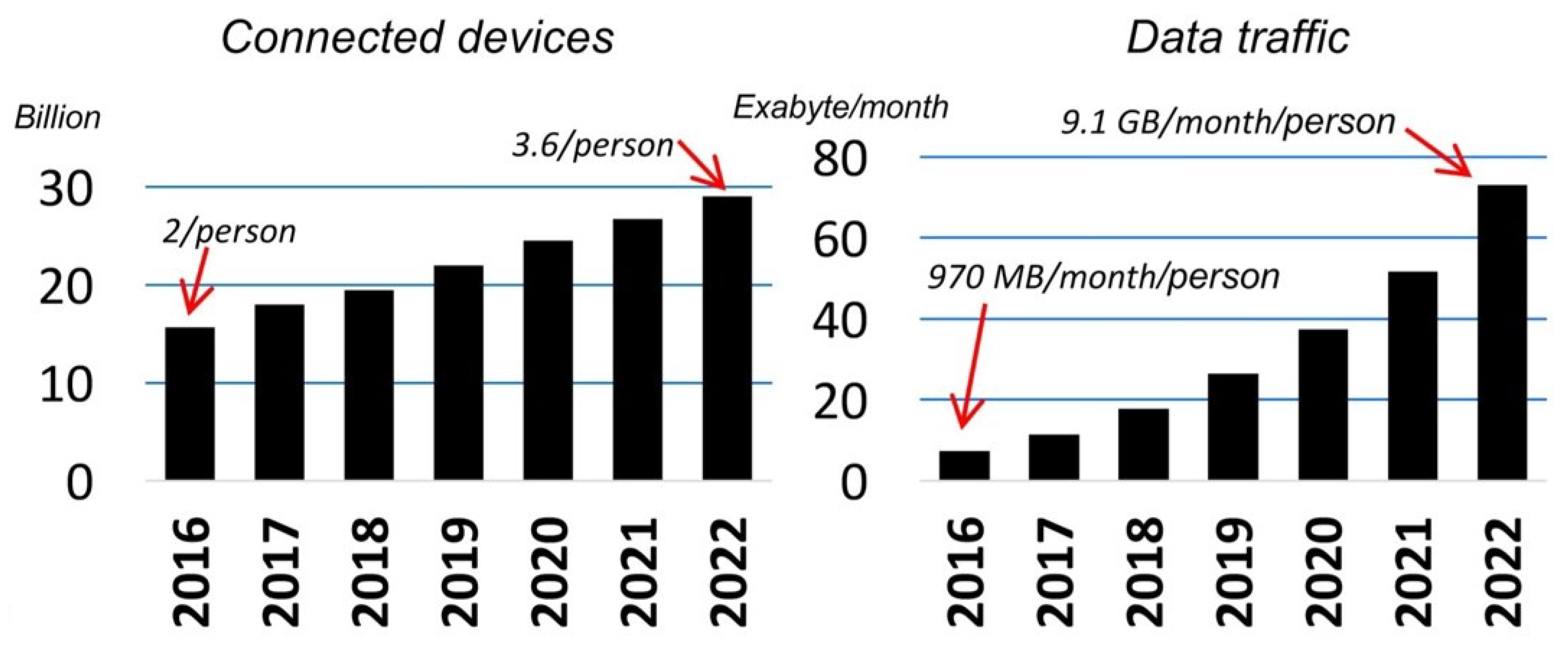
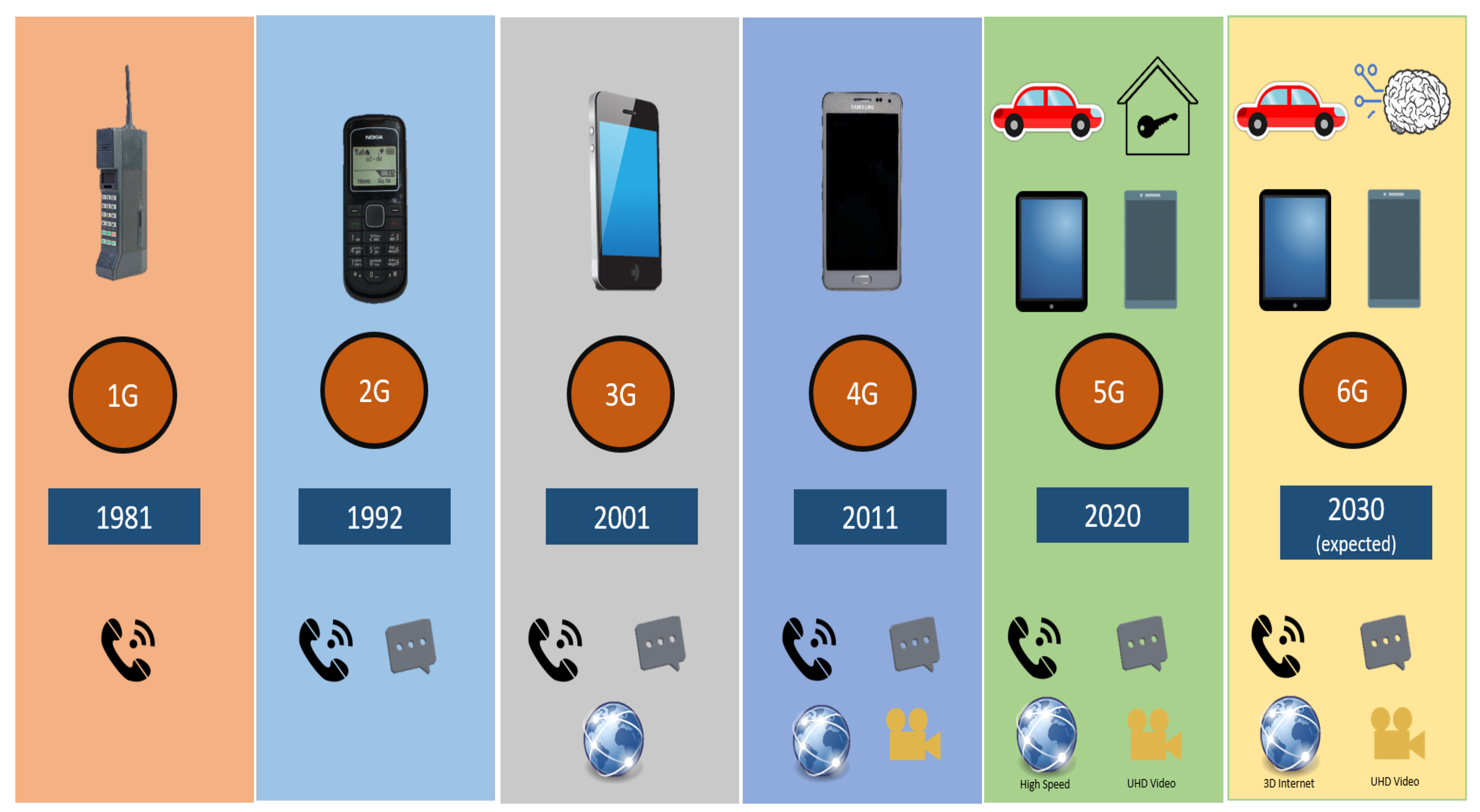
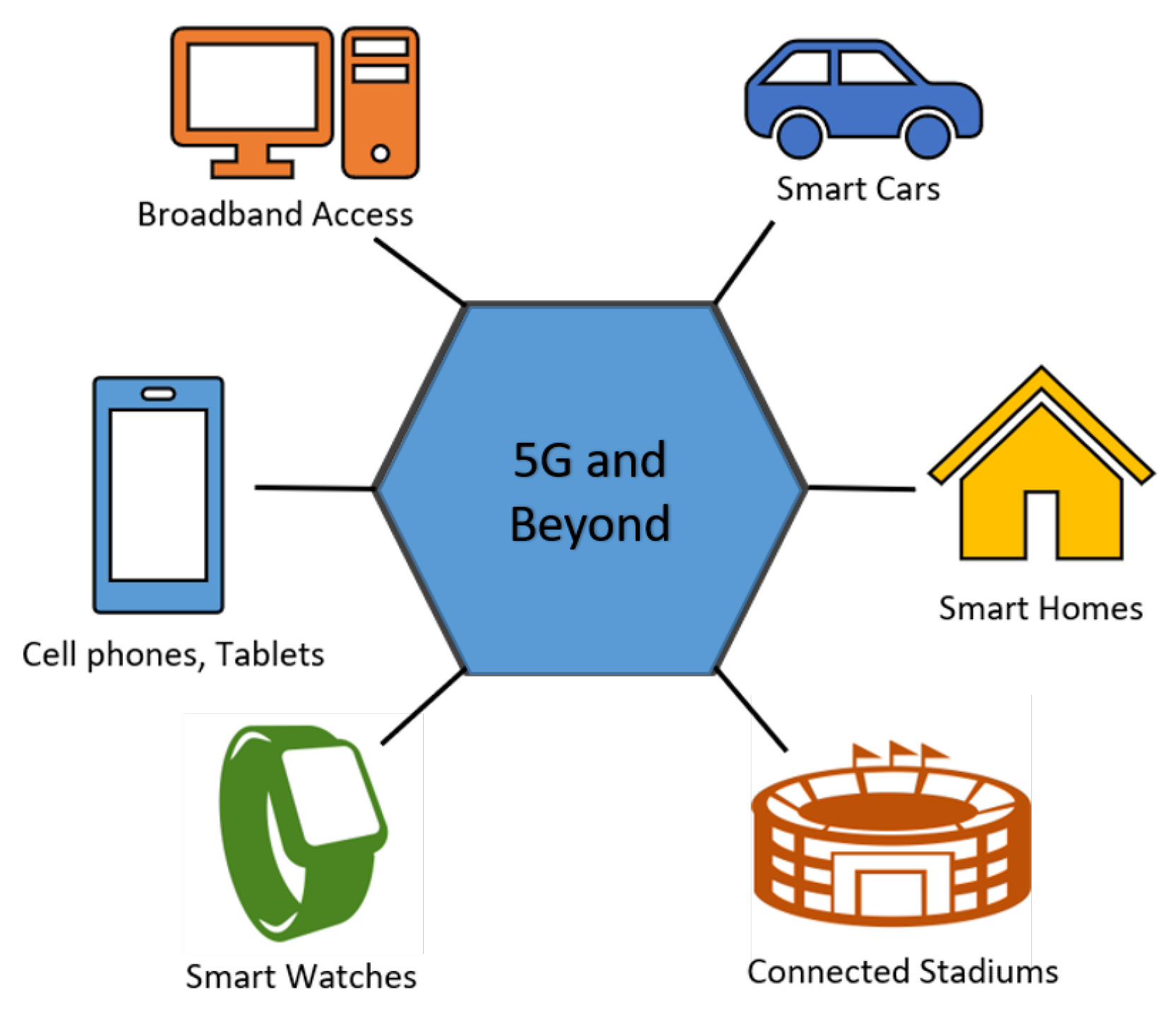
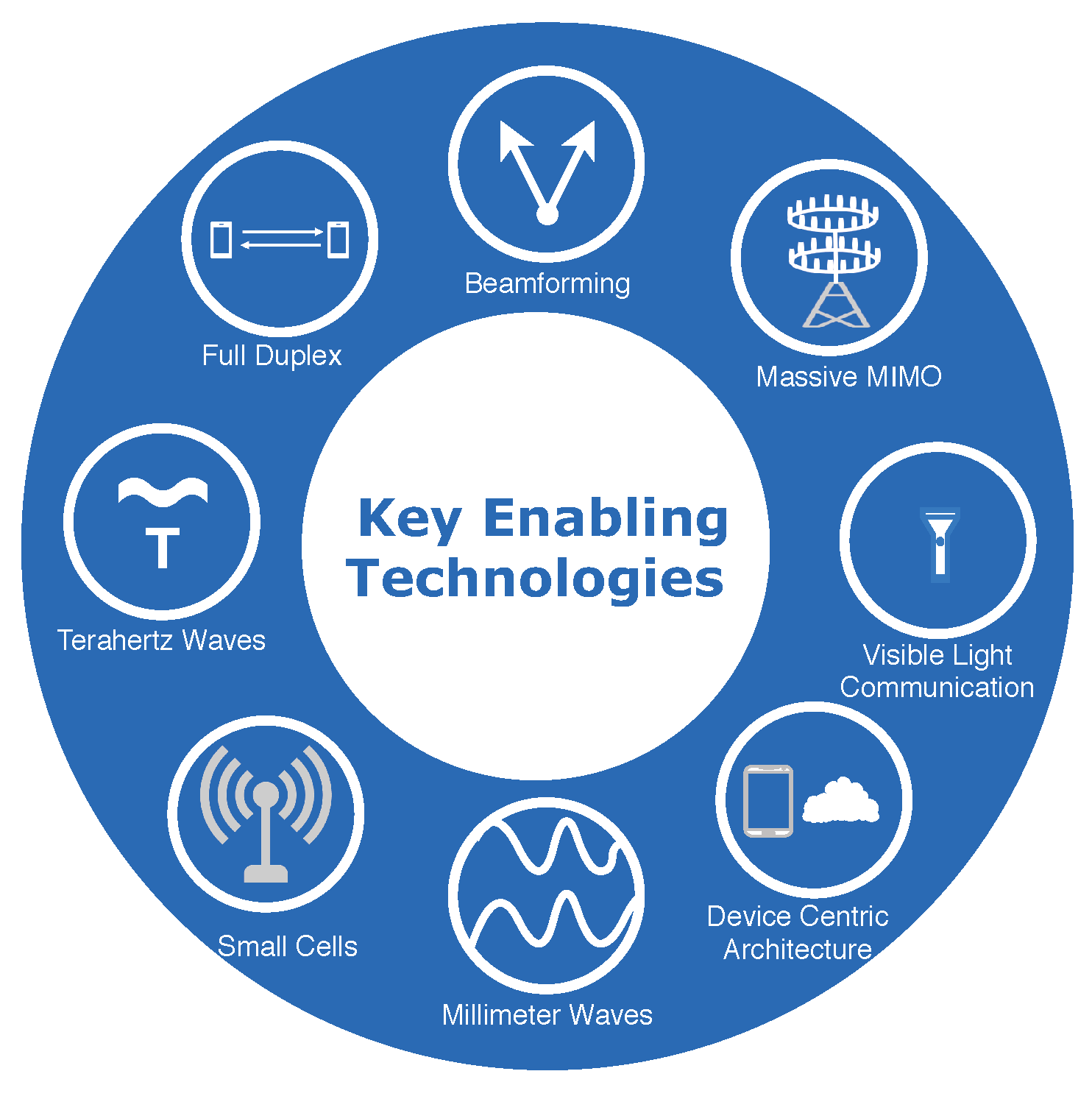

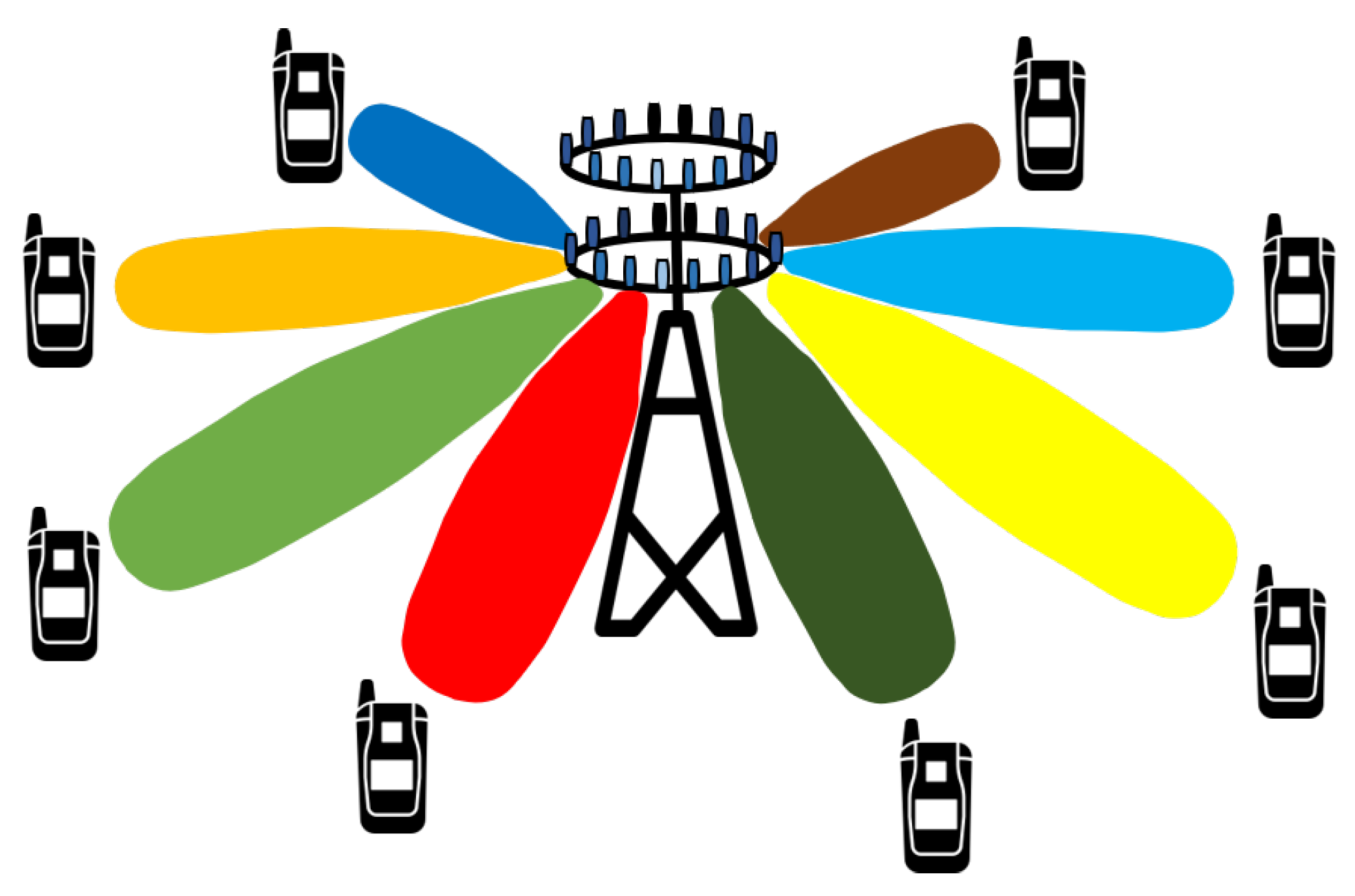
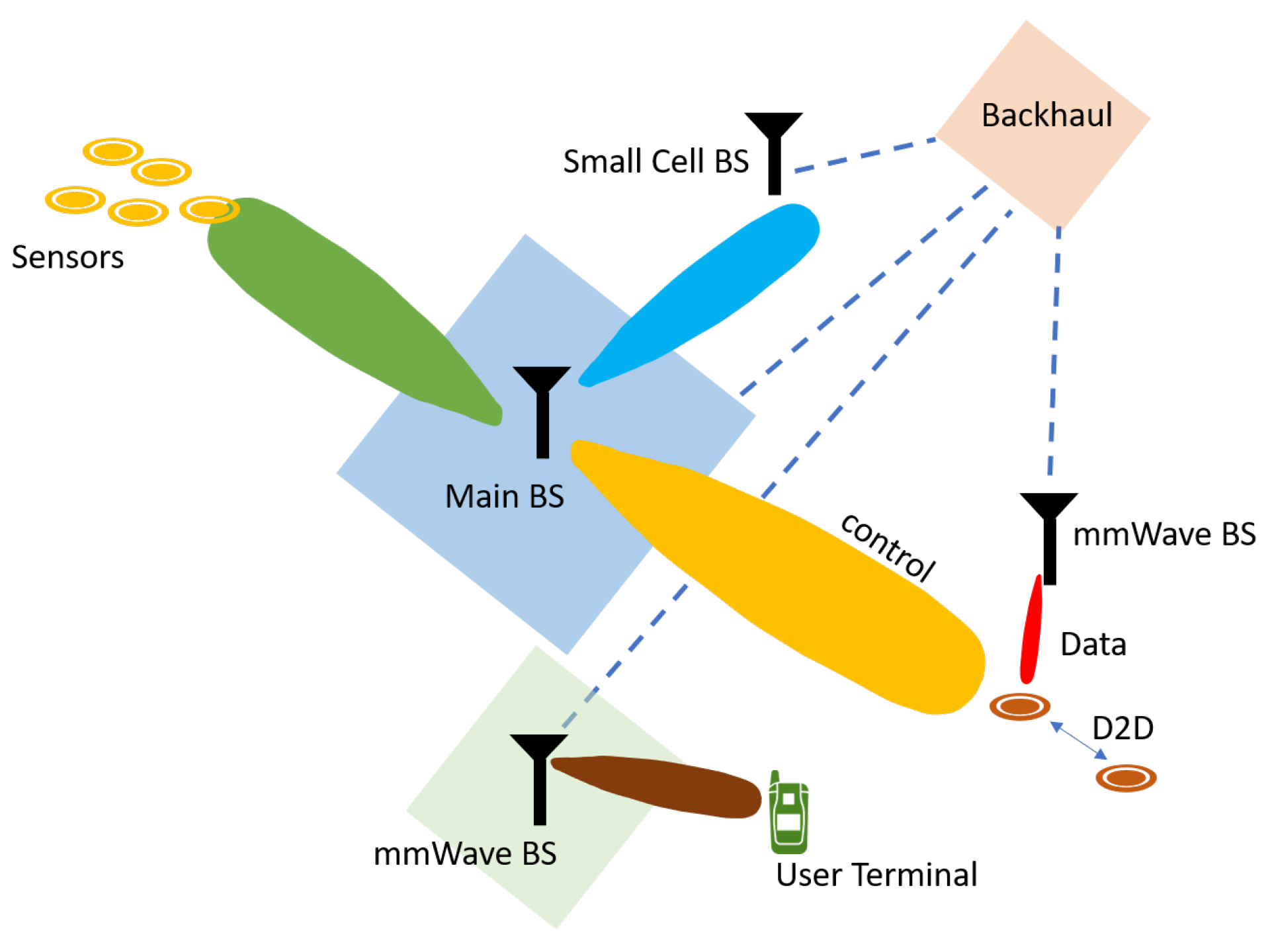
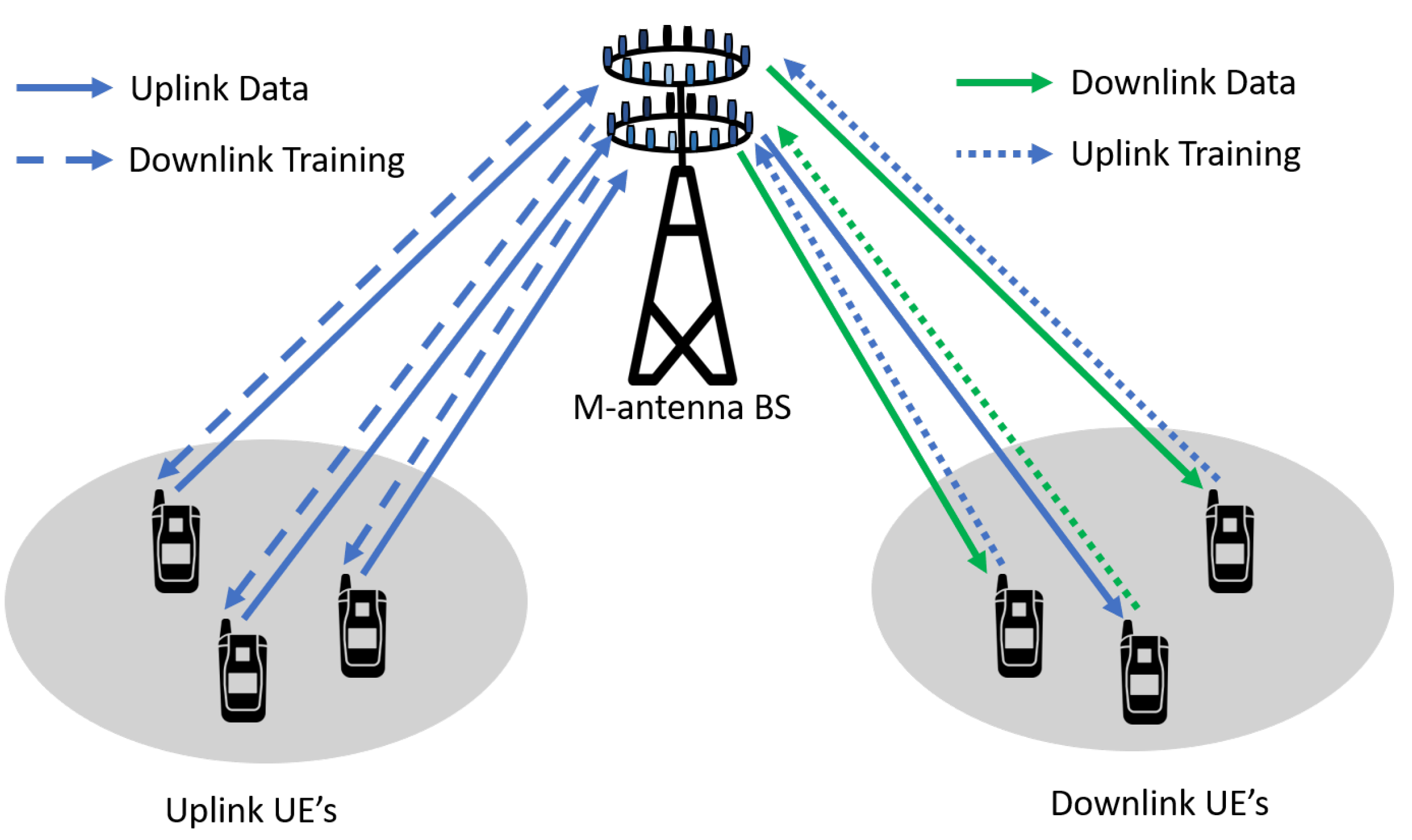
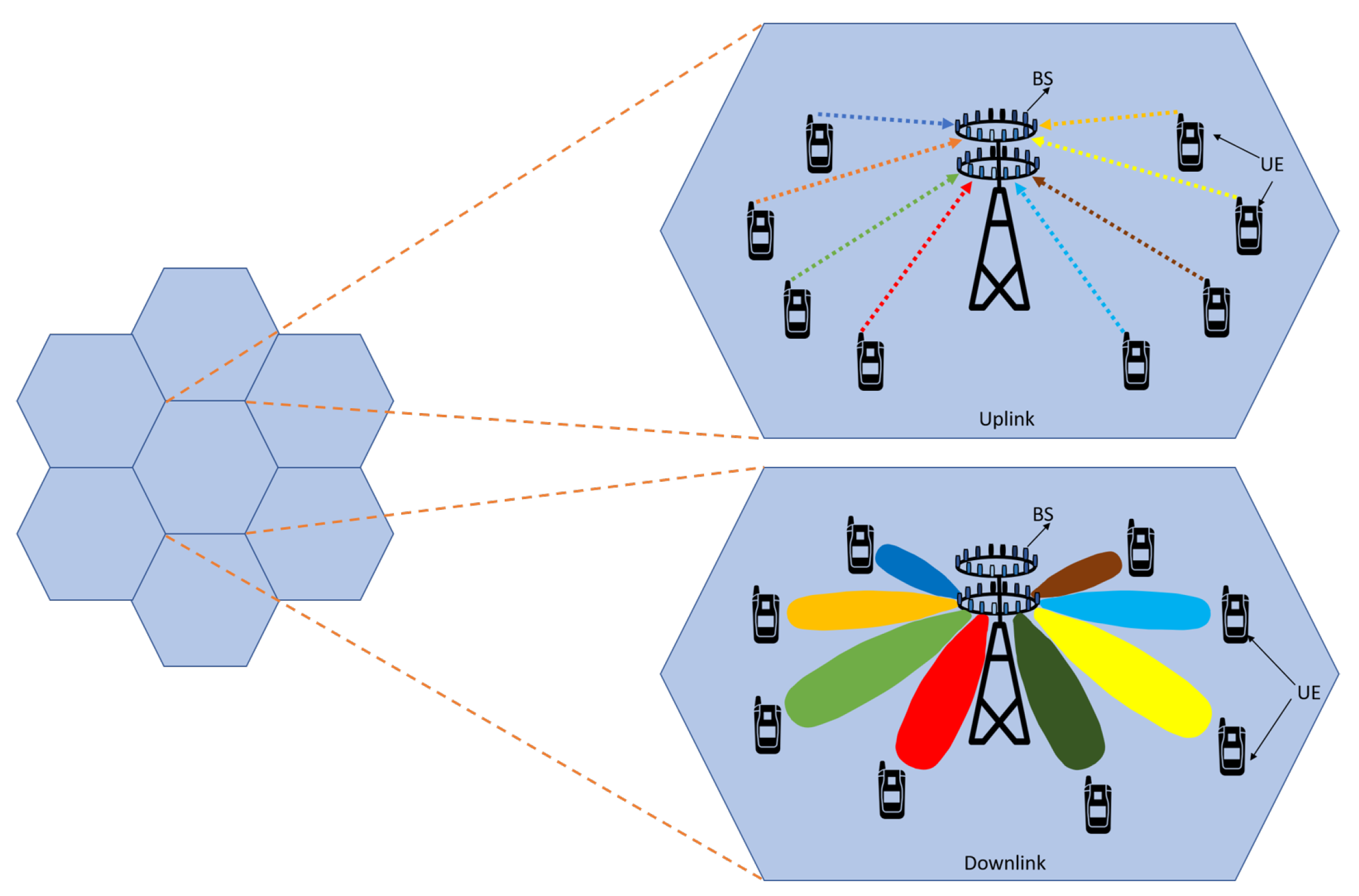
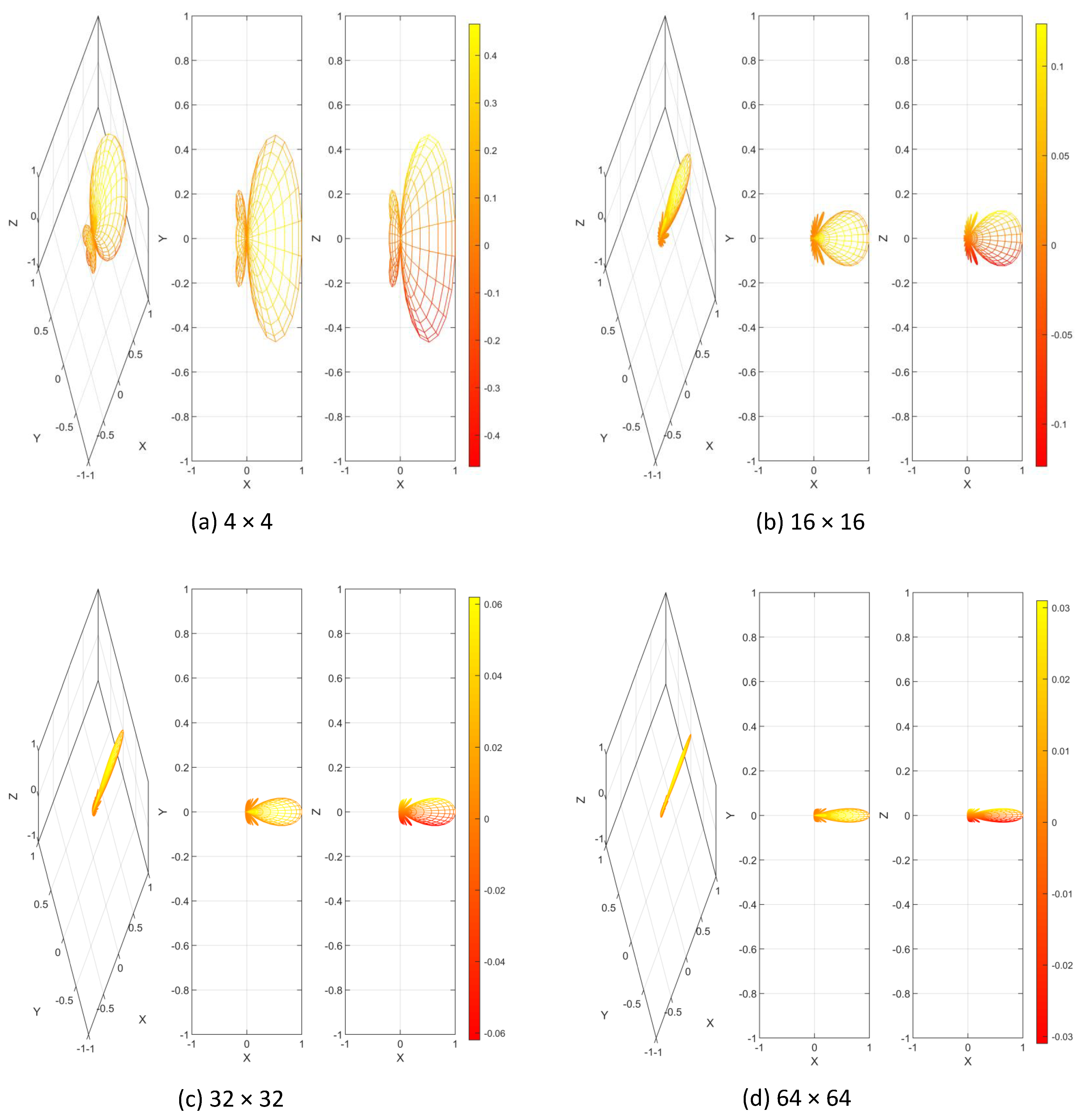
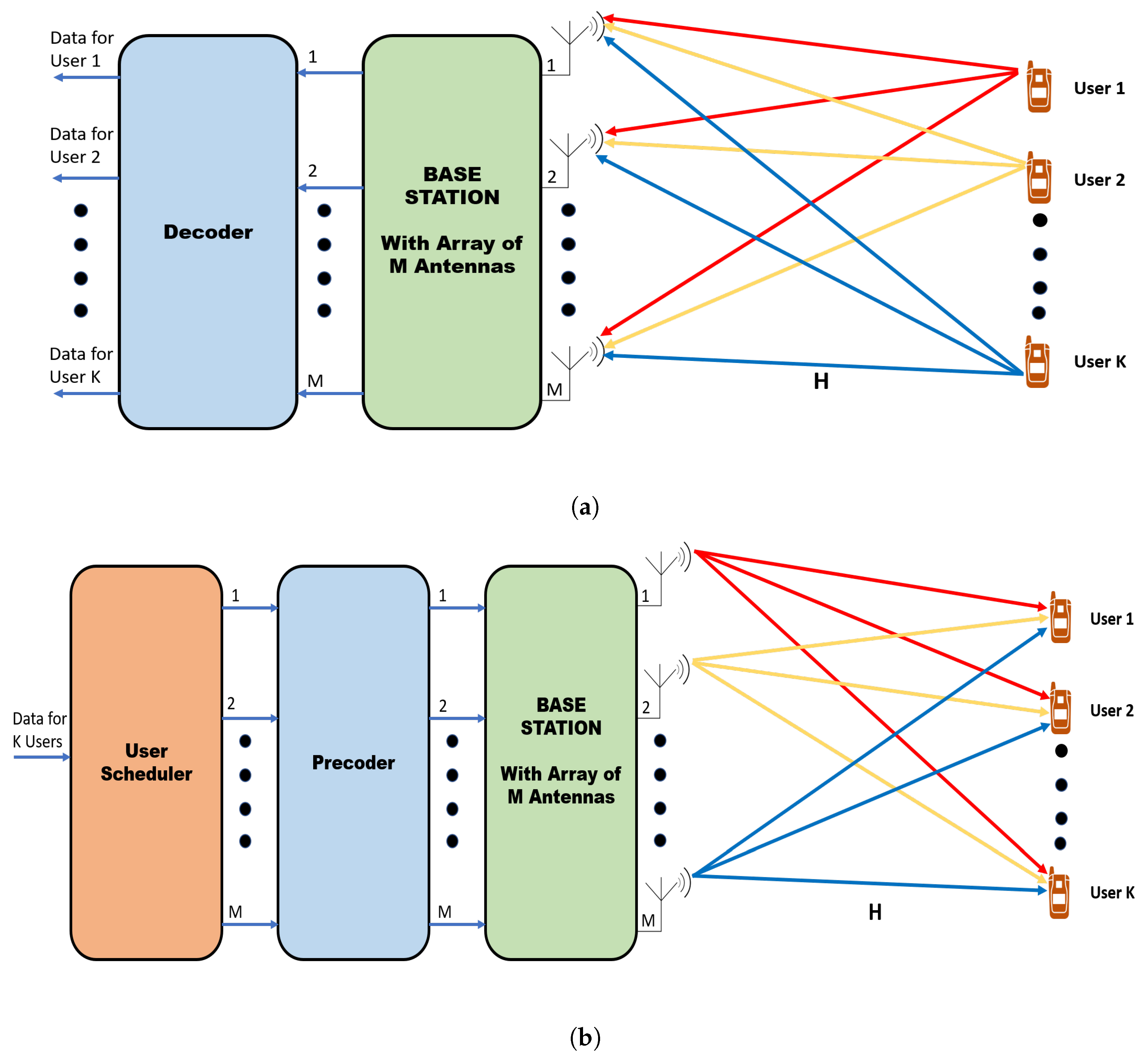
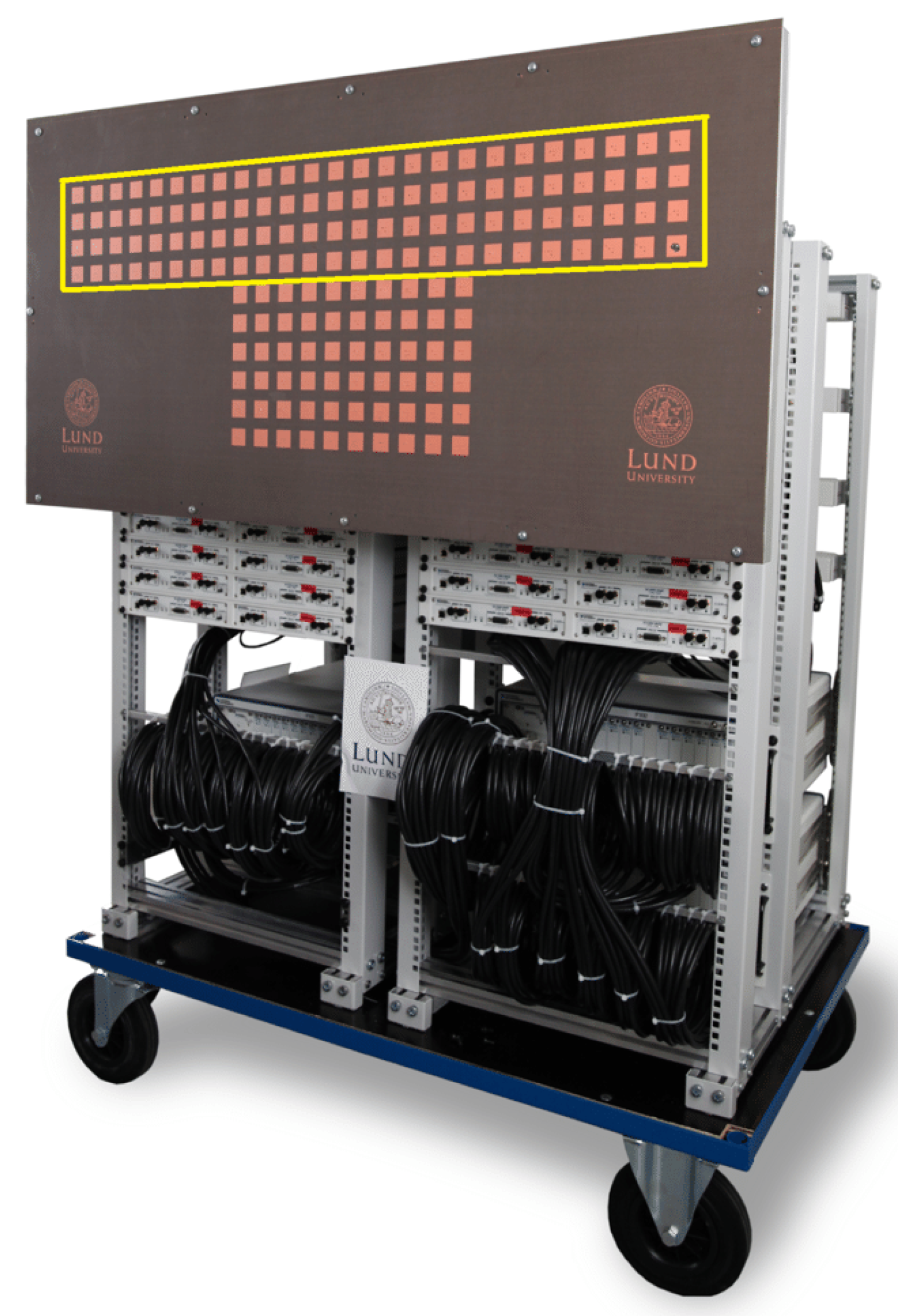
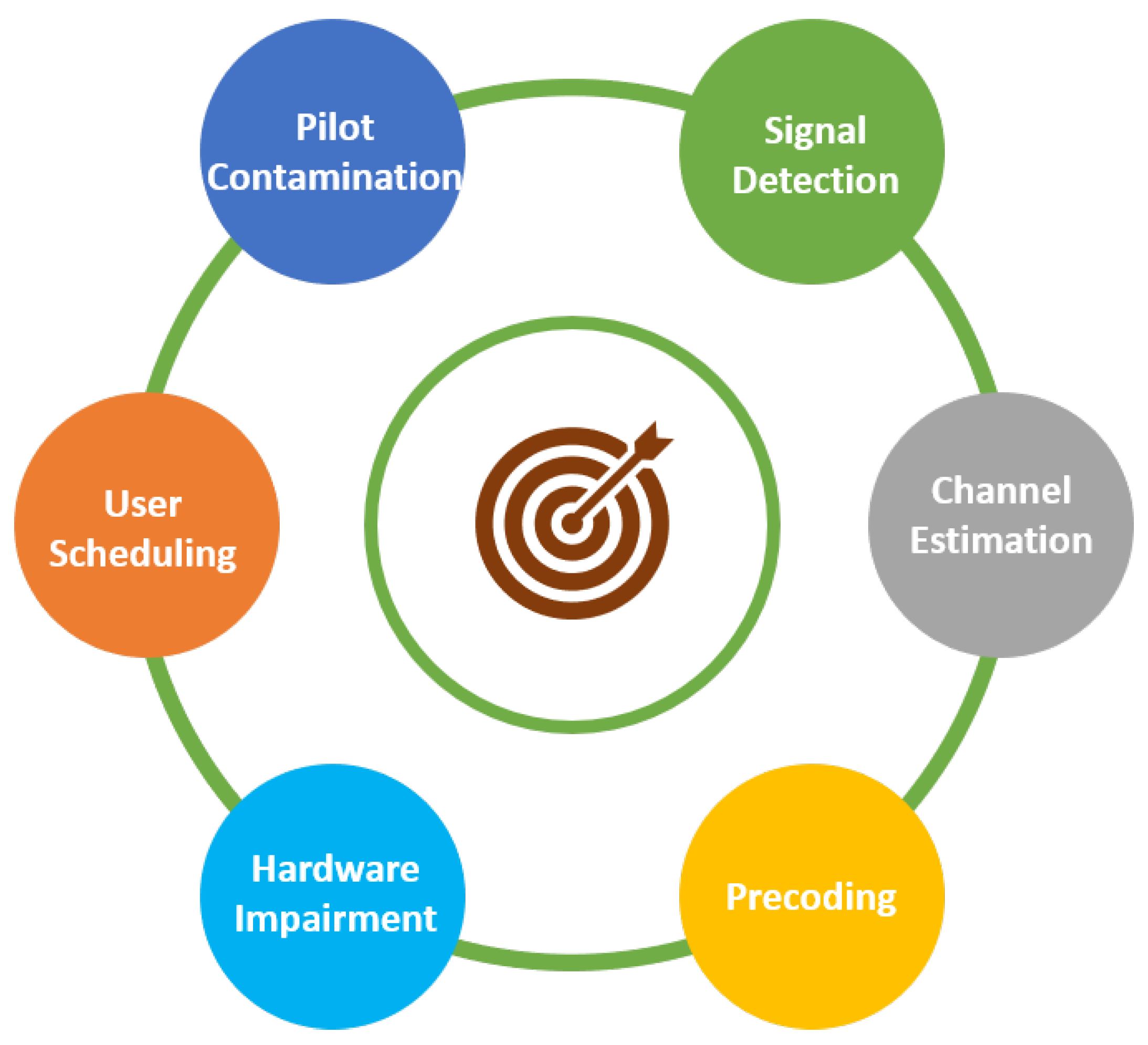
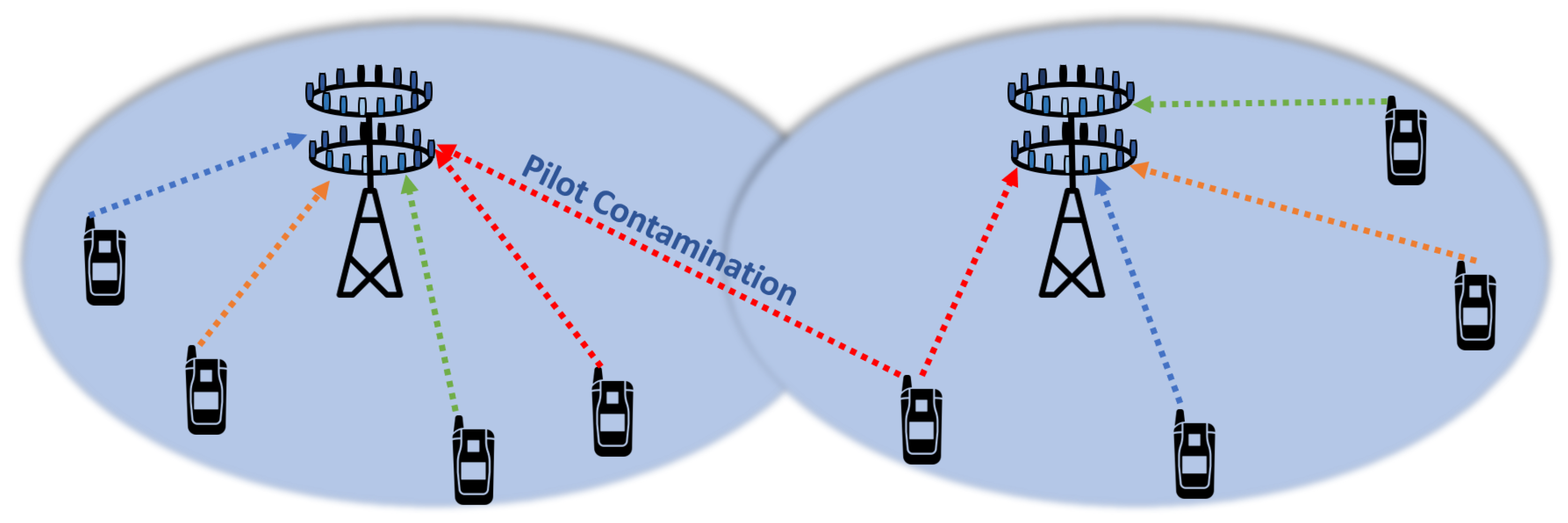
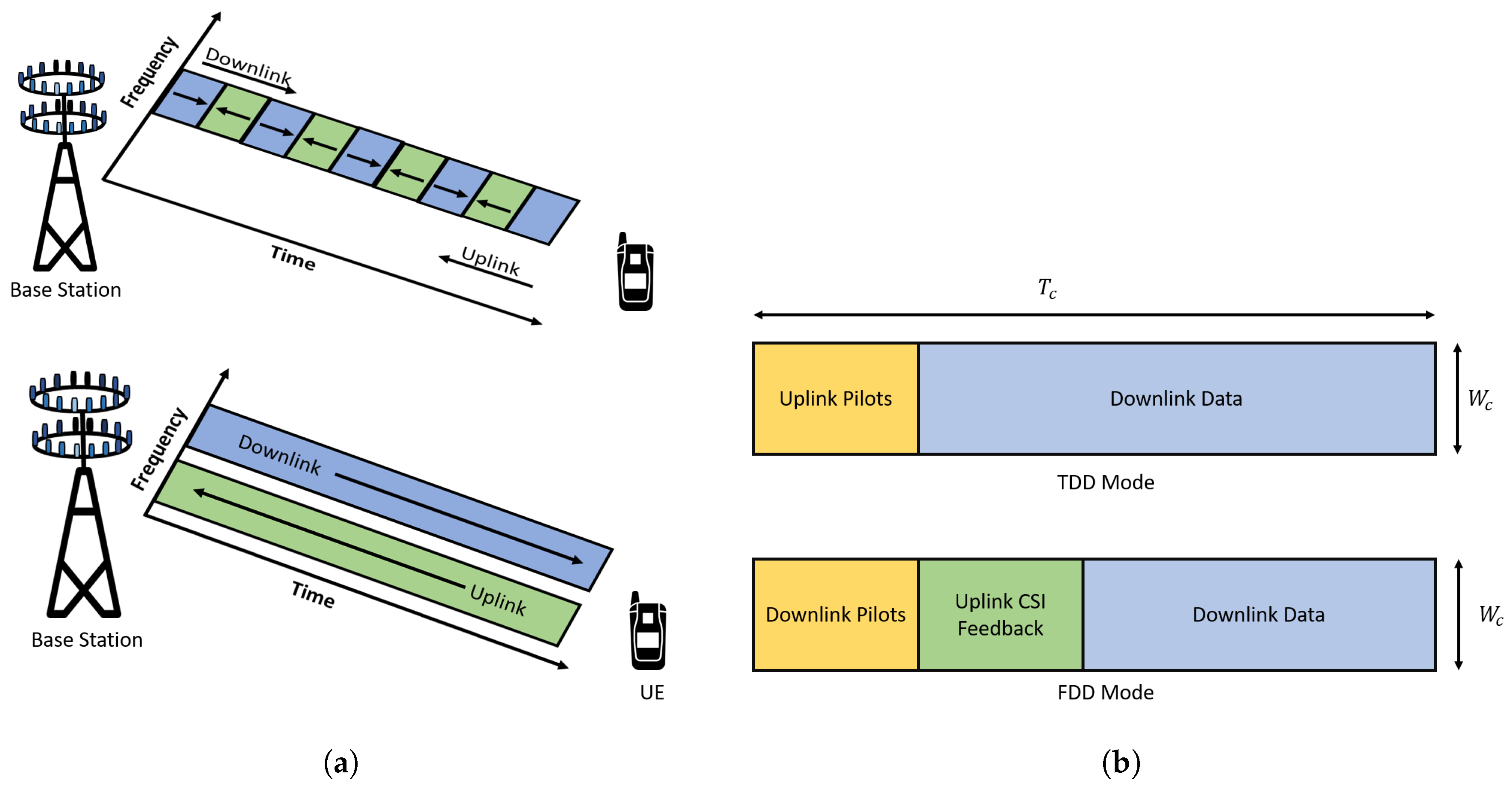
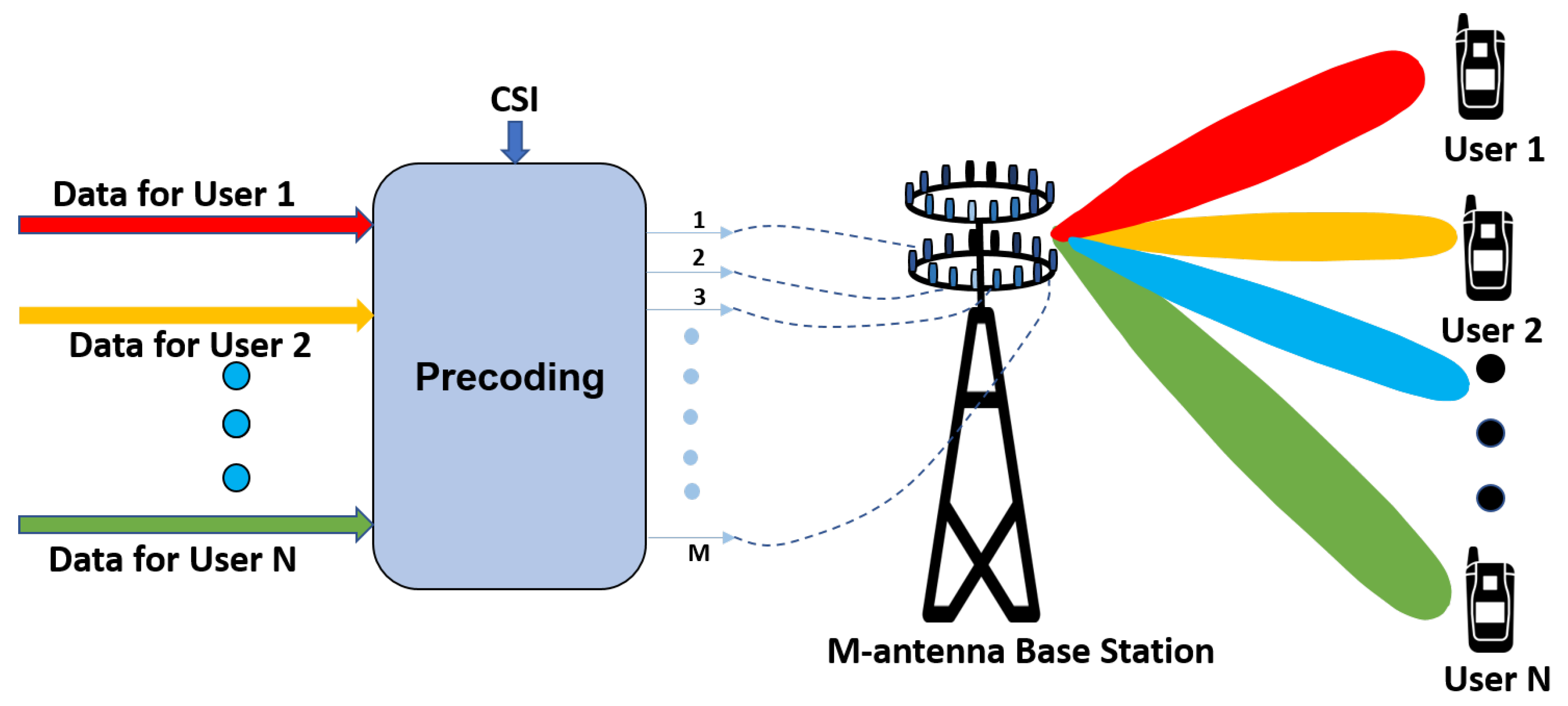

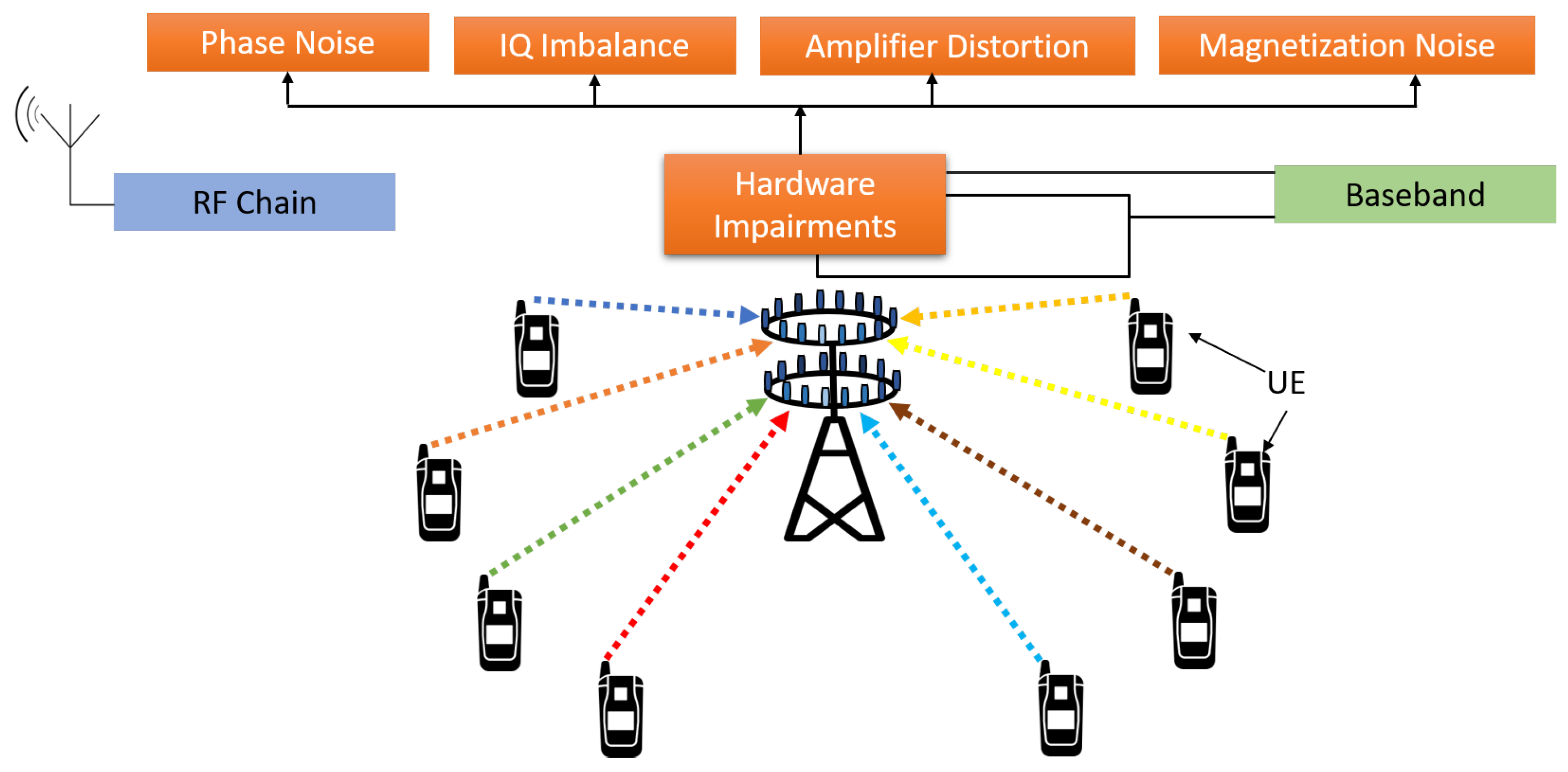
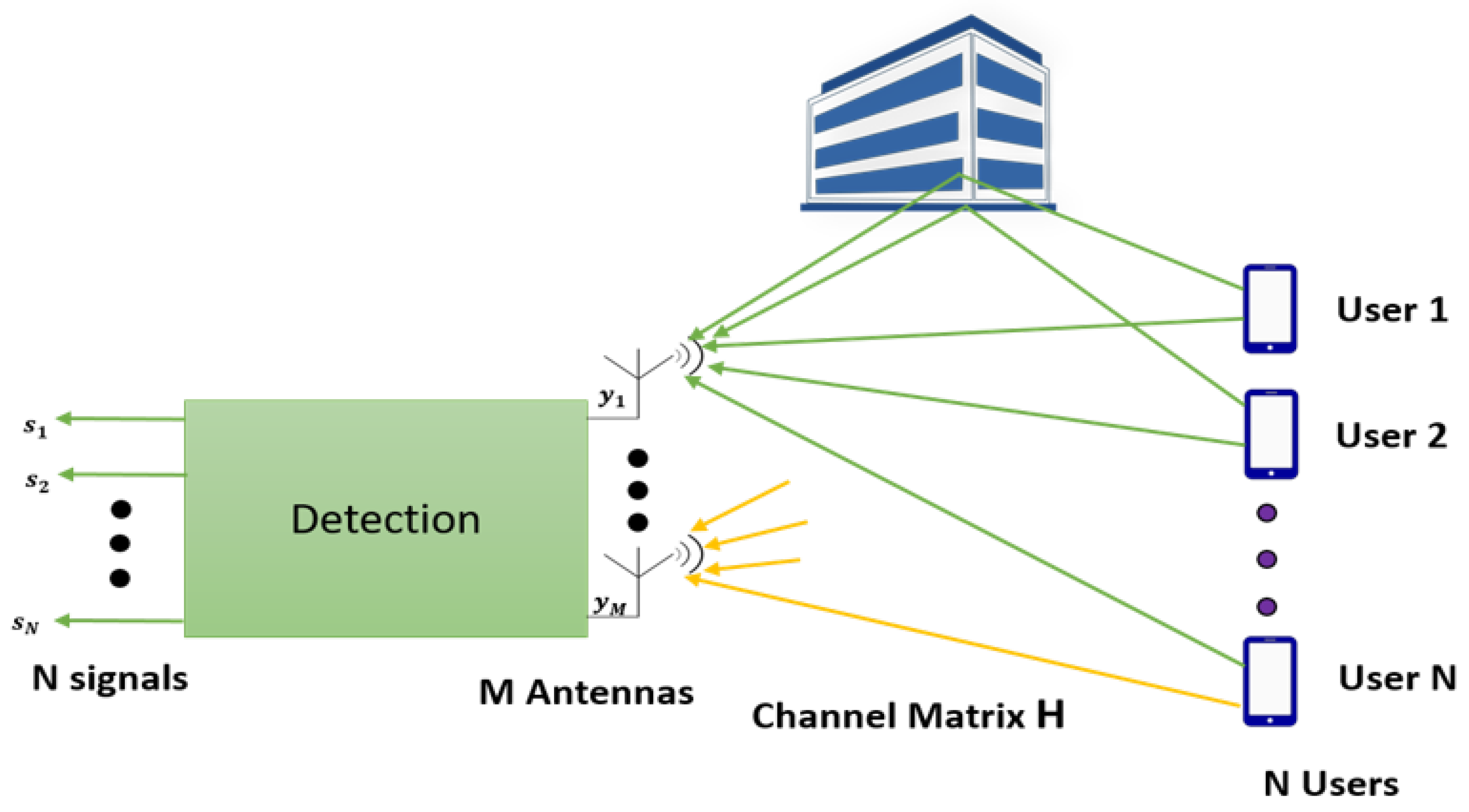
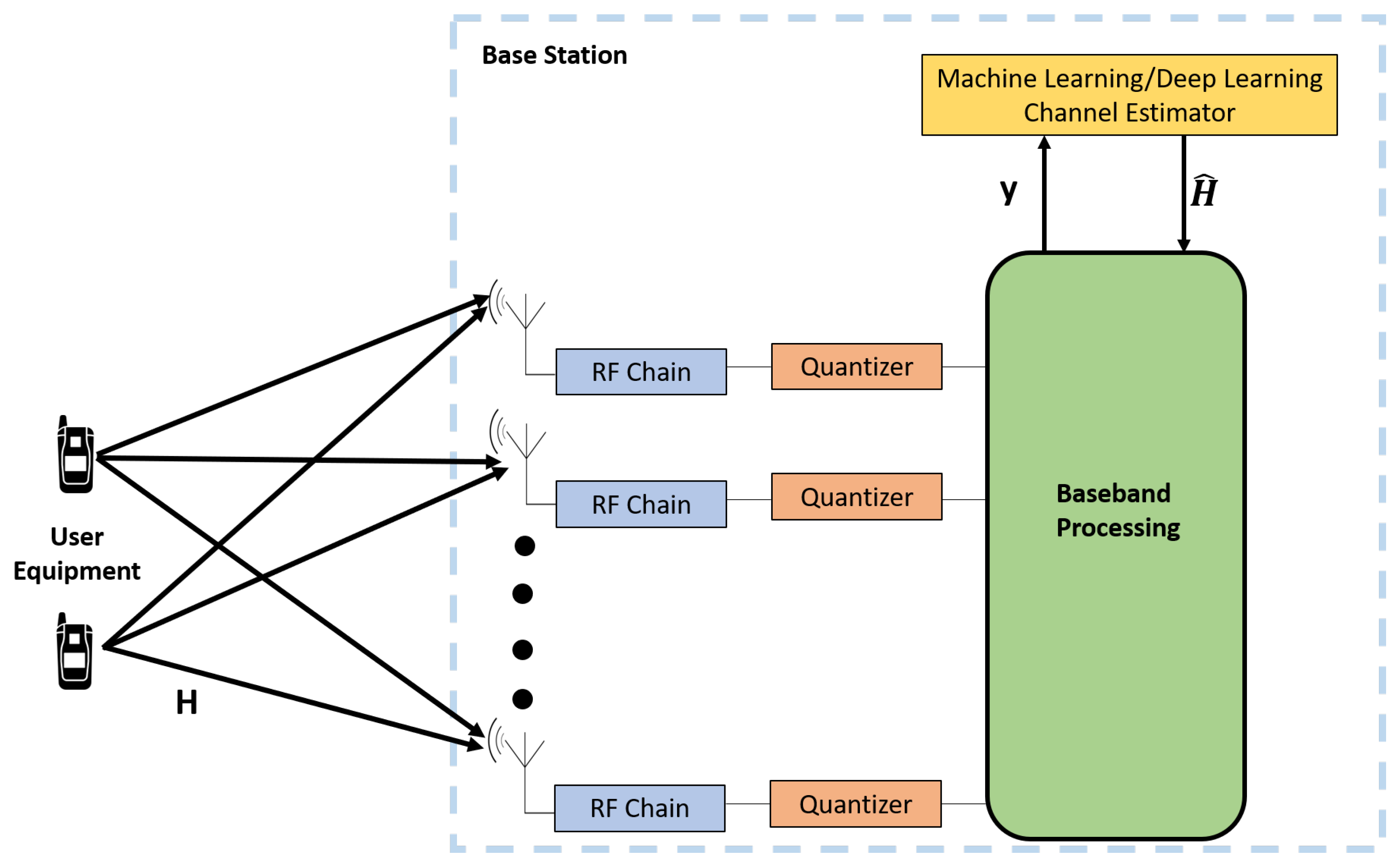
| Performance Index | 4G | 5G | 6G |
|---|---|---|---|
| Peak Data Rate | 100 Mbps | 10 Gbps | Upto 10 Tbps |
| Latency | 10 ms | 1 ms | Upto 0.1 ms |
| Connection Density | 0.1 million devices/km | 1 million devices/km | 10 million devices/km |
| Energy Efficiency | 1× | 100 × 4G | 100 × 5G |
| Spectral Efficiency | 1× | 100 × 4G | 100 × 5G |
| Available Spectrum | Upto 6 GHz | Upto 300 GHz | Upto 3 THz |
| Mobility | 200 m/h | 300 m/h | 600 m/h |
| Artificial Intelligence | No | Partial | Fully |
| MIMO | Massive MIMO | |
|---|---|---|
| Number of Antenna | ≤8 | ≥16 |
| Pilot Contamination | Low | High |
| Throughput | Low | High |
| Antenna Coupling | Low | High |
| Bit Error Rate | High | Low |
| Noise Resistance | Low | High |
| Diversity/Capacity Gain | Low | High |
| Energy Efficiency | Low | High |
| Cost | Low | High |
| Complexity | Low | High |
| Scalability | Low | High |
| Link Stability | Low | High |
| Antenna Correlation | Low | High |
| Feature | Massive MIMO System |
|---|---|
| Main aspect | Base station with hundreds of antennas |
| Multiple users | |
| Low power antennas | |
| Characteristics | Many more antennas than number of users |
| Multiplexing gain | |
| Small low power antennas | |
| Very directive signals | |
| Little interference leakage | |
| Technical Content | Number of antennas ≥ 16 |
| High channel capacity | |
| High throughput | |
| High antenna coupling | |
| Low BER | |
| High noise resistance | |
| High implementation cost | |
| High scalability | |
| High link stability | |
| High antenna correlation | |
| Benefits | High spectral efficiency |
| Array gain | |
| High energy efficiency | |
| High data rate | |
| User tracking | |
| Low power consumption | |
| Less fading | |
| Low latency | |
| More reliability | |
| Challenges | Pilot contamination |
| Channel estimation | |
| Precoding | |
| User scheduling | |
| Hardware impairments | |
| Energy efficiency | |
| Signal detection |
| Challenges | Mitigation Techniques |
|---|---|
| Pilot Contamination | Pilot based Estimation [58,59], Subspace based Estimation [60], Pilot Reuse [61], Partial Sounding Resource [62], Pilot Contamination Precoding [63], Blind Pilot Decontamination [64,65], Pilot Decontamination [69], Distributed Non-Orthogonal Pilot Design [70]. |
| Channel Estimation | Least Square [74], MMSE [75,76], Improved MMSE [77,78], Blind Estimation [80,81], Compresses Sensing [82,83], MICED [84], Untraind Deep Neural Network [85], Compressed Sensing [86], Convolutional Blind Denoising [87], VAMP [88], Deep Learning based Sparse Estimation [89], CNN based Estimation [150], Machine Learning based Estimate [151,158], Deep Learning based Estimation [153,155] |
| Precoding | DPP [93], TH [94,95], VP [96], MRC [97], ZF [98,99], WF [100], MMSE [101,102] |
| User Scheduling | ZF [105], MMSE [106], DPC [92], RR [107], PF [108], Greedy [109], Multi-user Grouping [112], Gibbs Distribution Scheme [114], Pilot Efficient Scheduling [115], Machine Learning based Scheduling [159] |
| Hardware Impairments | Digital Pre-Distortion [118,119], PAPR [120], |
| Signal Detection | SD [122], SIC [123], ML [47], ZF [124], MMSE [125], NSA [132], Richardson [133], SOR [74], Jacobi [134], Gauss Siedel [135], Conjugate Gradient [131], Least Square Regression Selection [136], Huber ADMM [137], AMP [138] Compressed Sensing based Adaptive Scheme [86], CNN [140], Gauss Siedel Refinement [143], SSL and SL based Detection [162,163], APRGS [169] |
© 2020 by the authors. Licensee MDPI, Basel, Switzerland. This article is an open access article distributed under the terms and conditions of the Creative Commons Attribution (CC BY) license (http://creativecommons.org/licenses/by/4.0/).
Share and Cite
Chataut, R.; Akl, R. Massive MIMO Systems for 5G and beyond Networks—Overview, Recent Trends, Challenges, and Future Research Direction. Sensors 2020, 20, 2753. https://doi.org/10.3390/s20102753
Chataut R, Akl R. Massive MIMO Systems for 5G and beyond Networks—Overview, Recent Trends, Challenges, and Future Research Direction. Sensors. 2020; 20(10):2753. https://doi.org/10.3390/s20102753
Chicago/Turabian StyleChataut, Robin, and Robert Akl. 2020. "Massive MIMO Systems for 5G and beyond Networks—Overview, Recent Trends, Challenges, and Future Research Direction" Sensors 20, no. 10: 2753. https://doi.org/10.3390/s20102753
APA StyleChataut, R., & Akl, R. (2020). Massive MIMO Systems for 5G and beyond Networks—Overview, Recent Trends, Challenges, and Future Research Direction. Sensors, 20(10), 2753. https://doi.org/10.3390/s20102753





